Arizona is home to a variety of bird species, each of which has its unique characteristics. From the vibrant colors of the painted red-headed woodpecker to the majestic flight of the bald eagle, Arizona’s bird population is diverse and fascinating.
From the high desert of the Grand Canyon to the lush forests of the White Mountains, the state offers a wide range of habitats for birds of all shapes and sizes.
This article will explore the different species of birds that can be found in Arizona, highlighting their varied characteristics and behavior.
1. Songbirds
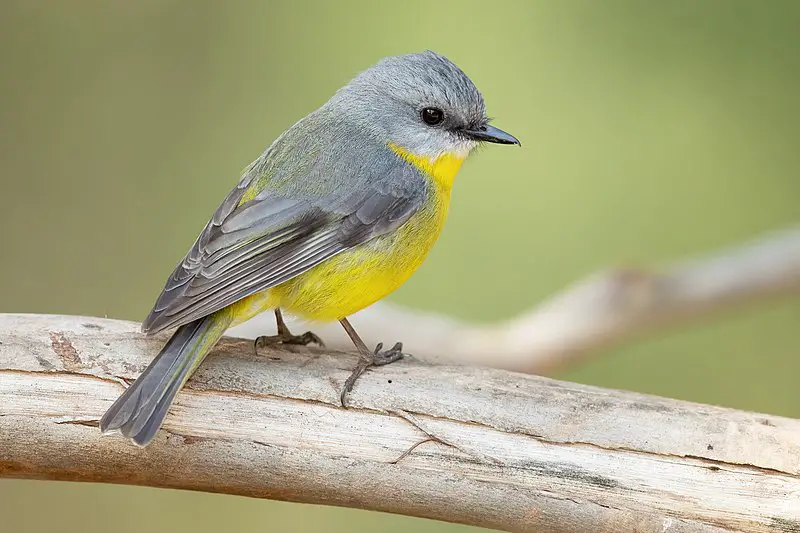
Songbirds are a special suborder of perching birds found all over the world. These beautiful creatures have intricate vocal organs that allow them to produce elaborate bird songs, making them stand out from other species.
With around 5,000 different types of songbirds in existence, they come in various sizes and colors with complex feathers adding to their beauty.
Songbirds play an important role in eco-systems as they help disperse seeds by eating fruit and insects which act as agents for pollination.
Their presence also serves to attract more biodiversity into areas where these delicate animals live, creating vibrant habitats full of life.
Scientific classification:
| Kingdom | Animalia |
| Phylum | Chordata |
| Class | Aves |
| Order | Passeriformes |
| Clade | Eupasseres |
| Suborder | Passeri Linnaeus, 1758 |
2. House Finch

The House Finch is a species of finch native to western North America and has been introduced in the eastern half of the continent as well as Hawaii.
It’s an average-sized finch with adults measuring 12.5 – 15 cm (5 – 6 inches) long and having wingspans between 20 – 25 cm (8 – 10 inches).
The upperparts are brown, while its underparts range from pale grayish white to yellow depending on subspecies.
Its face is streaked or spotted with reddish coloration; males typically have brighter plumage than females due to sexual dimorphism.
They’re mostly found near human habitations such as farms and gardens where they feed on grains, fruits, insects etc., making them very popular among birders who want something colorful for their backyard.
Scientific classification:
| Kingdom | Animalia |
| Phylum | Chordata |
| Class | Aves |
| Order | Passeriformes |
| Family | Fringillidae |
| Subfamily | Carduelinae |
| Genus | Haemorhous |
| Species | H. mexicanus |
3. Northern Cardinal
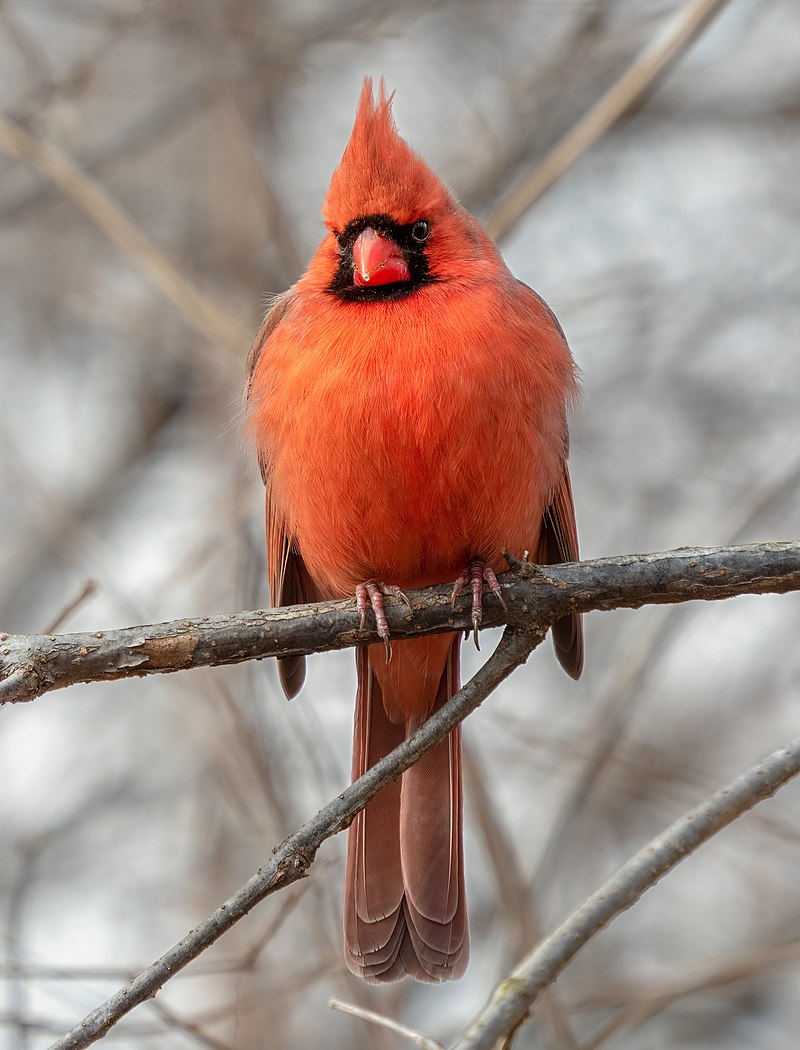
The Northern Cardinal is a beautiful bird, easily identified by its bright red plumage. It can be found in the eastern United States from Maine to Minnesota and south through Mexico and Belize.
Along with its striking coloration, it has a distinctive crest on its head and sharp black facial markings around the eyes.
Despite their small size (measuring 7-9 inches), they are very vocal birds – males sing persistently throughout springtime to attract mates or proclaim their territory.
They typically feed on insects, seeds, and fruits but also enjoy suet at backyard bird feeders.
The female is less brightly colored than her mate but still stands out among other songbirds due to her warm brownish-red feathers.
Cardinals pair for life so you may often see them together in your garden or neighborhood park.
Scientific classification:
| Kingdom | Animalia |
| Phylum | Chordata |
| Class | Aves |
| Order | Passeriformes |
| Family | Cardinalidae |
| Genus | Cardinalis |
| Species | C. cardinalis |
4. Gila Woodpecker
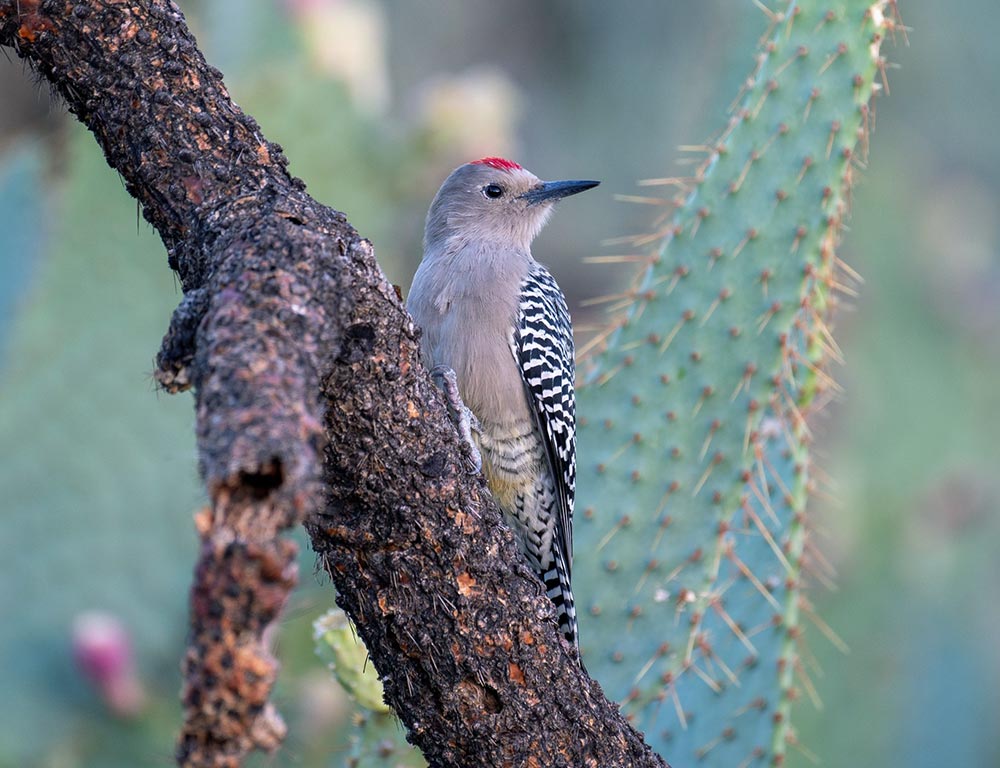
The Gila woodpecker is a medium-sized bird found in the desert regions of the southwestern United States and western Mexico.
It has a unique coloration, featuring black and white zebra-like stripes on its back, wings, and tail feathers.
Its neck, throat belly, and head are greyish tan in color with small red or yellow spots on its nape.
They feed mainly on insects but have been known to eat berries when available during winter months.
These birds are social creatures that often nest together in large colonies to increase their chances of survival against predators such as hawks or owls.
The Gila woodpecker plays an important role in maintaining healthy ecosystems by eating destructive beetles while also spreading seeds from the cacti they consume throughout the year.
Scientific classification:
| Kingdom | Animalia |
| Phylum | Chordata |
| Class | Aves |
| Order | Piciformes |
| Family | Picidae |
| Genus | Melanerpes |
| Species | M. uropygialis |
5. Anna’s Hummingbird
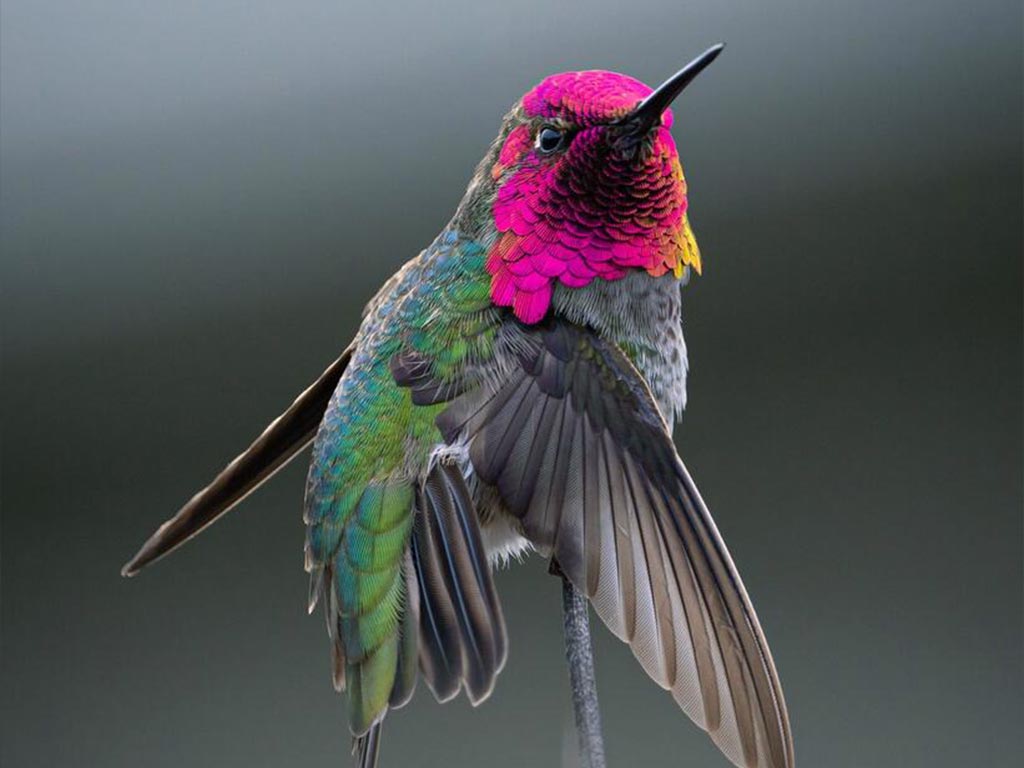
Anna’s hummingbird is a beautiful species of bird belonging to the Trochilidae family. Native to western coastal regions of North America, it was named after Anna Masséna, Duchess of Rivoli.
In the early 20th century, these birds bred only in northern Baja California and southern California but due to ornamental plant transplanting they can now be found across much of the Pacific Coast region.
They are medium-sized with bright emerald green feathers on their back and crowns as well as rose-red patches at the throat for males which makes them quite distinguishable from other birds.
Their diet consists mainly of nectar from flowers although they will occasionally feed on insects or spiders too making them important pollinators that help maintain healthy ecosystems.
Scientific classification:
| Kingdom | Animalia |
| Phylum | Chordata |
| Class | Aves |
| Order | Apodiformes |
| Family | Trochilidae |
| Genus | Calypte |
| Species | C. anna |
6. Cactus Wren
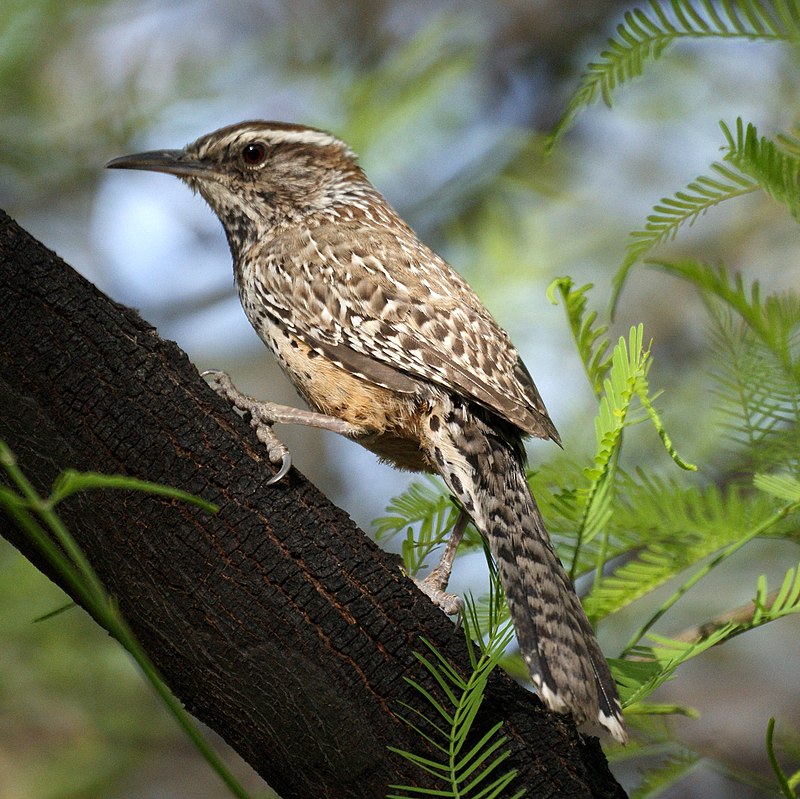
The cactus wren is an enchanting bird found in the deserts of the southwestern United States and northern and central Mexico.
It has a unique brown plumage, with black and white spots as markings, along with a distinctive white eyebrow sweeping to its nape.
Its chest is also snow-white, whereas its belly features light brown bars that contrast nicely against other feathers.
This species holds special significance for Arizona – it was declared their state bird due to its large size compared to other US wrens.
Cactus Wrens are often seen perched atop Saguaro cacti or jumping around on desert ground searching for food such as insects like beetles or spiders.
Scientific classification:
| Kingdom | Animalia |
| Phylum | Chordata |
| Class | Aves |
| Order | Passeriformes |
| Family | Troglodytidae |
| Genus | Campylorhynchus |
| Species | C. brunneicapillus |
7. Mourning Dove
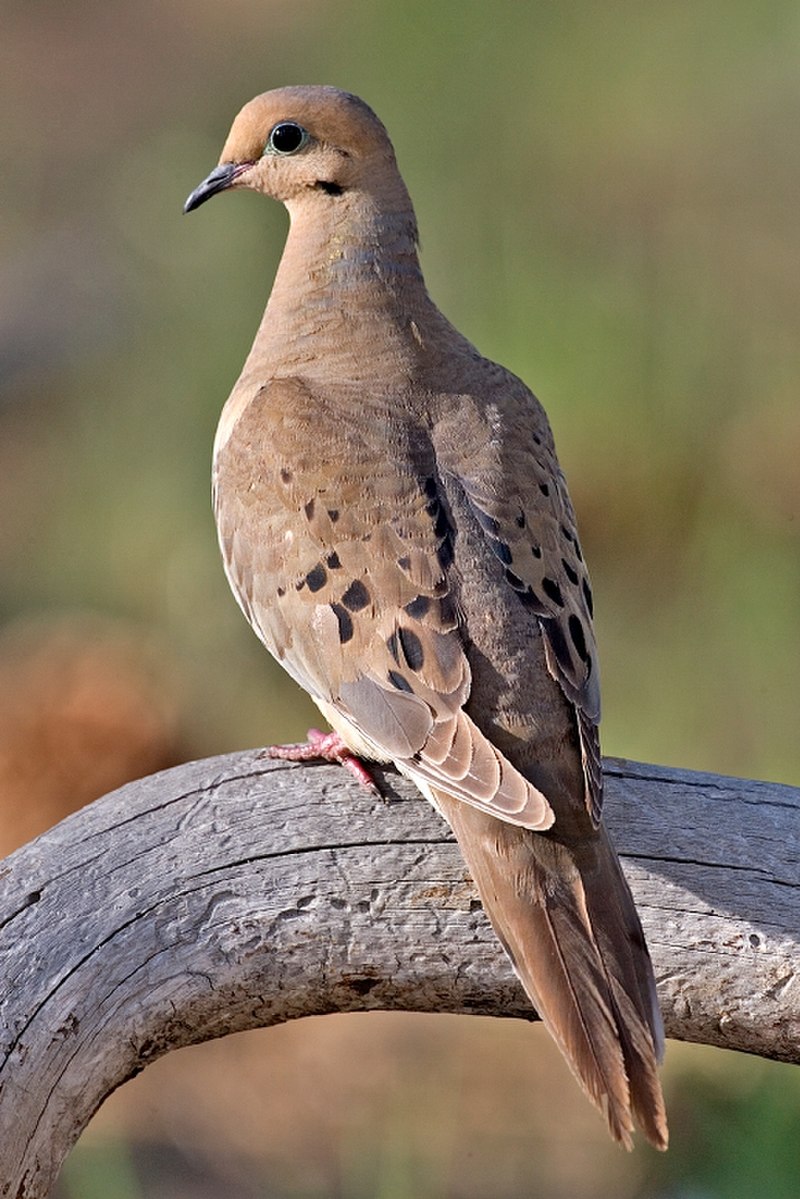
The Mourning Dove is a breathtakingly beautiful bird. It has stunning gray and brown feathers with white-tipped wings, giving it an elegant appearance. Its long tail also adds to its graceful look in flight.
A symbol of peace and serenity, they are abundant across North America and can be found in gardens or open fields throughout the year.
As well as being popular game birds for hunters, they feed on grains such as wheat and millet providing important food sources for wildlife species including foxes, coyotes, skunks, and raccoons.
These doves have a distinctive cooing sound that can often be heard echoing through woodlands during summer evenings making them one of nature’s greatest treasures.
Scientific classification:
| Kingdom | Animalia |
| Phylum | Chordata |
| Class | Aves |
| Order | Columbiformes |
| Family | Columbidae |
| Genus | Zenaida |
| Species | Z. macroura |
8. Lesser Goldfinch
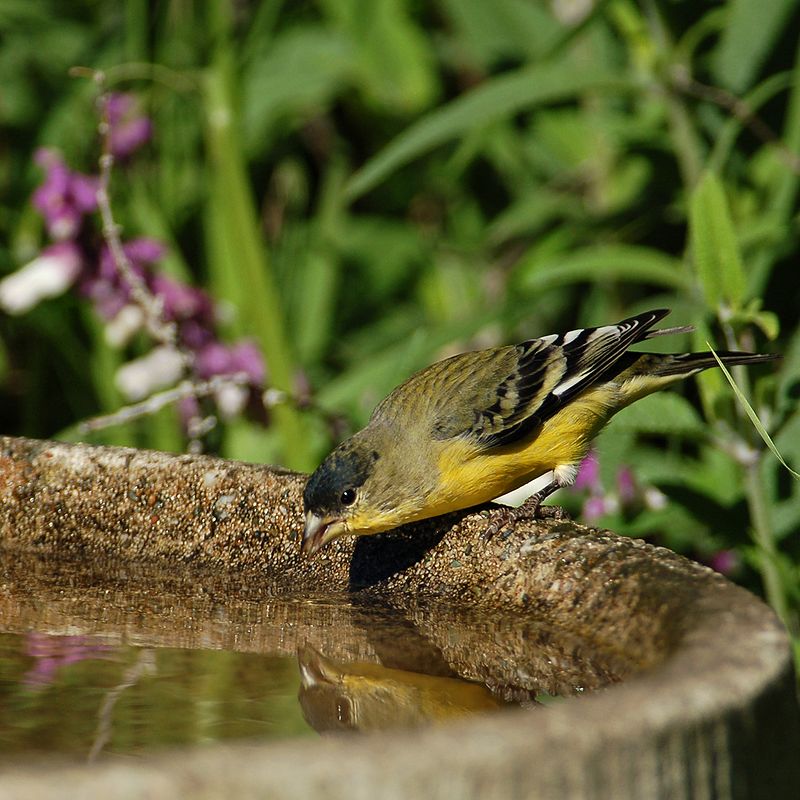
The Lesser Goldfinch is a tiny species of bird found in the Americas. It belongs to the same clade as American goldfinches and Lawrence’s goldfinches, which can be identified by their males having black or rarely green foreheads.
The face appears red or yellow on these birds, unlike other species in its genus Spinus sensu stricto.
They are small songbirds with short bills, brown wings and tails with white edges, grey-brown backs, and olive heads.
These birds inhabit open woodlands and fields where they feed mainly on seeds from weeds such as thistle, pigweed, and ragweed but also consume insects at times during the breeding season for additional nutrition.
In addition to being an important part of North America’s avian ecology, these birds have been popularized through recent artwork depicting them in various poses among flowers.
Scientific classification:
| Kingdom | Animalia |
| Phylum | Chordata |
| Class | Aves |
| Order | Passeriformes |
| Family | Fringillidae |
| Subfamily | Carduelinae |
| Genus | Spinus |
| Species | S. psaltria |
9. Verdin
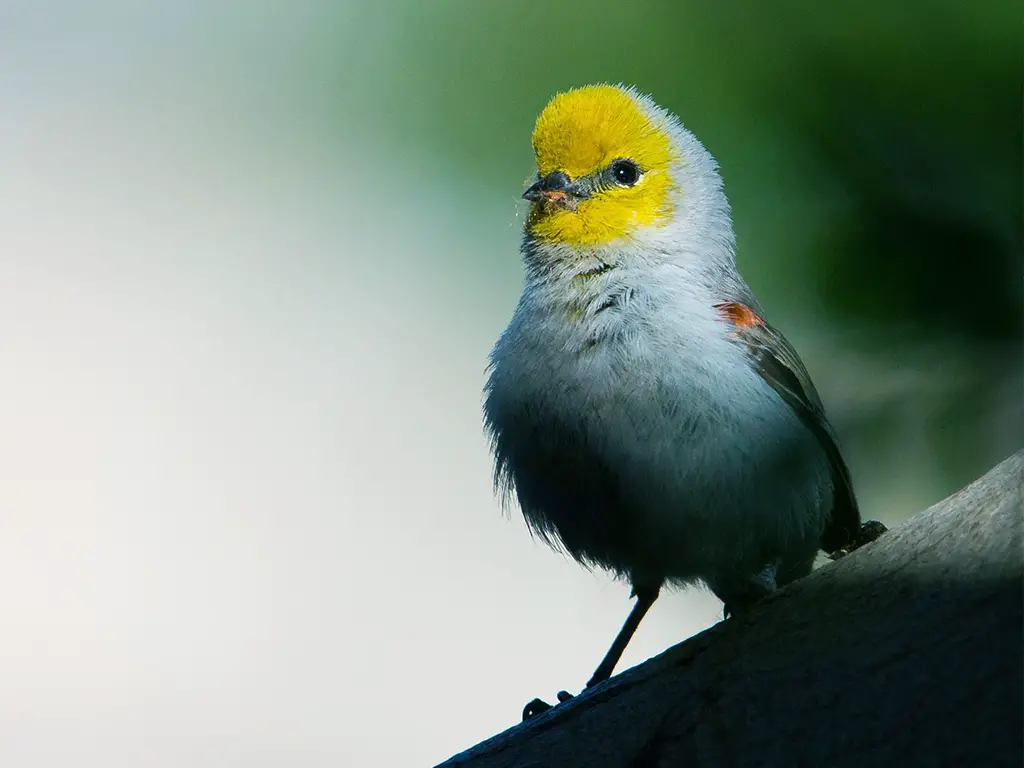
Verdin is a species of penduline tit, the only one in its genus Auriparus and family Remizidae found in North America.
It was formally described by Swedish zoologist Carl Jakob Sundevall under the binomial name Aegithalus flaviceps in 1850.
This small bird has an olive-grey coloration on its head, back, and wings while having white coloring around its face with yellowish patches near the eyes.
The underside is pale grey with brown tinge while the feet are pinkish/brown tinted. Its diet consists mainly of insects which it forages from tree branches or shrubs.
During mating season they build intricate nests made up of grasses and moss lined inside with feathers or fur held together by spider webs usually suspended from thorny trees close to water sources like rivers or streams.
It makes them ideal for rearing young chicks before their migration towards the south during winter months.
Scientific classification:
| Kingdom | Animalia |
| Phylum | Chordata |
| Class | Aves |
| Order | Passeriformes |
| Family | Remizidae |
| Genus | Auriparus S.F. Baird, 1864 |
| Species | A. flaviceps |
Also Featured In: Phoenix Birds You Should Know, Birds that Live in the Deserts
10. Northern Mockingbird
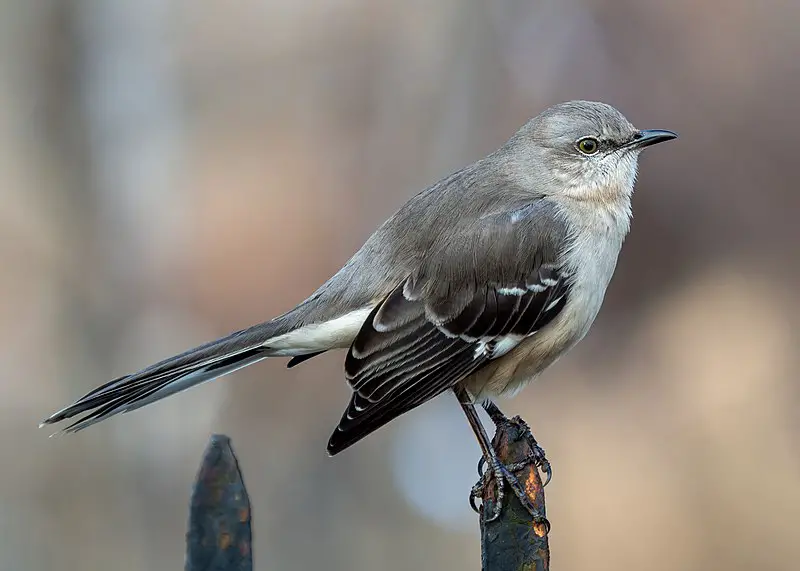
The northern mockingbird is a common fixture in North American skies. It has greyish-brown upperparts and a paler underside with white wing patches, and its distinctive long tail makes it easy to spot.
This adaptable bird can often be seen singing from the tops of trees or fences, though it rarely strays into Europe.
The species was first described by Carl Linnaeus in his 1758 Systema Naturae as Turdus polyglottos – aptly named for their remarkable ability to mimic other birds’ songs.
Northern mockingbirds typically live on insects, fruits, berries, and seeds but they will also happily scavenge food scraps left out by humans.
With its beautiful song and striking plumage, this beloved avian makes an important contribution to our environment.
Scientific classification:
| Kingdom | Animalia |
| Phylum | Chordata |
| Class | Aves |
| Order | Passeriformes |
| Family | Mimidae |
| Genus | Mimus |
| Species | M. polyglottos |
11. Curve-Billed Thrasher
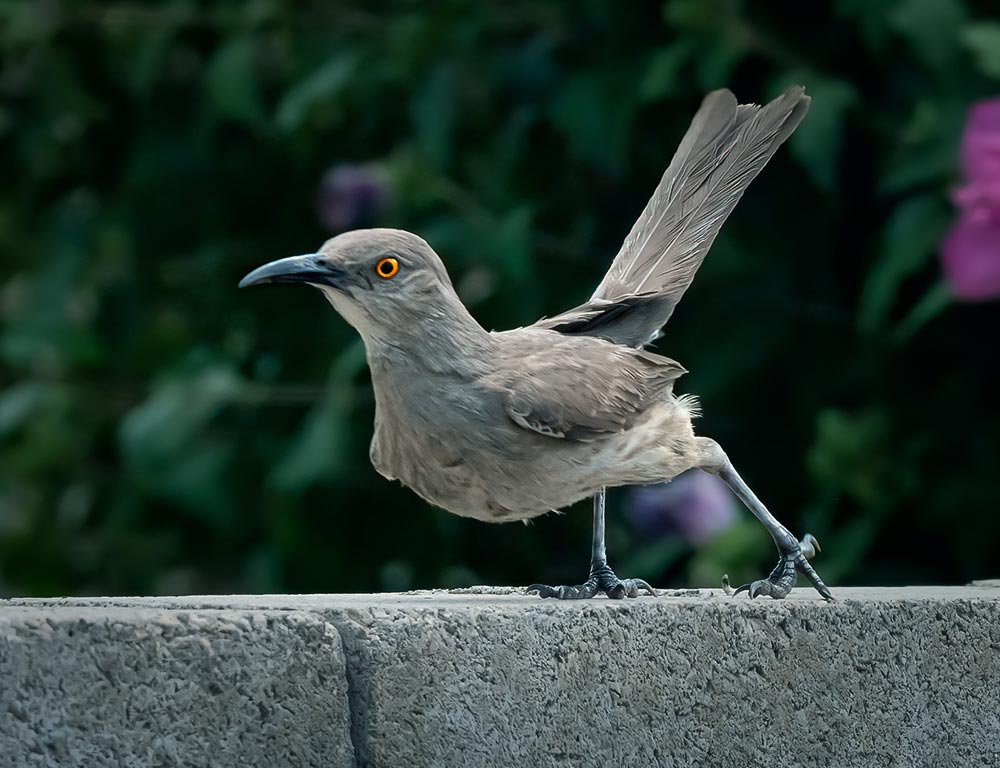
The Curve-billed Thrasher is a medium-sized bird native to Mexico and the southwestern United States. It lives mainly in desert areas, where it can be found foraging on the ground for its insect prey.
Its name comes from its curved bill, which aids in rooting out insects and other food sources.
The species has several subspecies that are geographically separated throughout much of their range; allopatric speciation likely played an important role here as well.
Despite being non-migratory, this thrasher will sometimes travel long distances when resources become scarce or during courtship displays with potential mates.
A successful predator of grasshoppers, beetles, and other arthropods, the Curve-billed Thrasher plays an essential role in maintaining healthy ecosystems by controlling pest populations.
Scientific classification:
| Kingdom | Animalia |
| Phylum | Chordata |
| Class | Aves |
| Order | Passeriformes |
| Family | Mimidae |
| Genus | Toxostoma |
| Species | T. curvirostre |
Also Featured In: Birds You’ll Find in South Texas , Birds You’ll Find in the Rio Grande Valley
12. Common Starling

The Common Starling is a medium-sized passerine bird that belongs to the Starling family. It has glossy black plumage with a metallic sheen, and at certain times of the year, it can be speckled with white.
The bill and legs are typically pink or black depending on the season, while its length measures about 8 inches long.
Its diet consists mainly of insects but also includes small fruits and seeds as well as some human food waste.
They live in large flocks which protects predators, although they can become quite aggressive when defending their nesting sites during breeding seasons.
Overall, this species is highly adaptable and widely distributed across many parts of Europe making them one of the most successful birds in the region today.
Scientific classification:
| Kingdom | Animalia |
| Phylum | Chordata |
| Class | Aves |
| Order | Passeriformes |
| Family | Sturnidae |
| Genus | Sturnus |
| Species | S. vulgaris |
13. White-Winged Dove
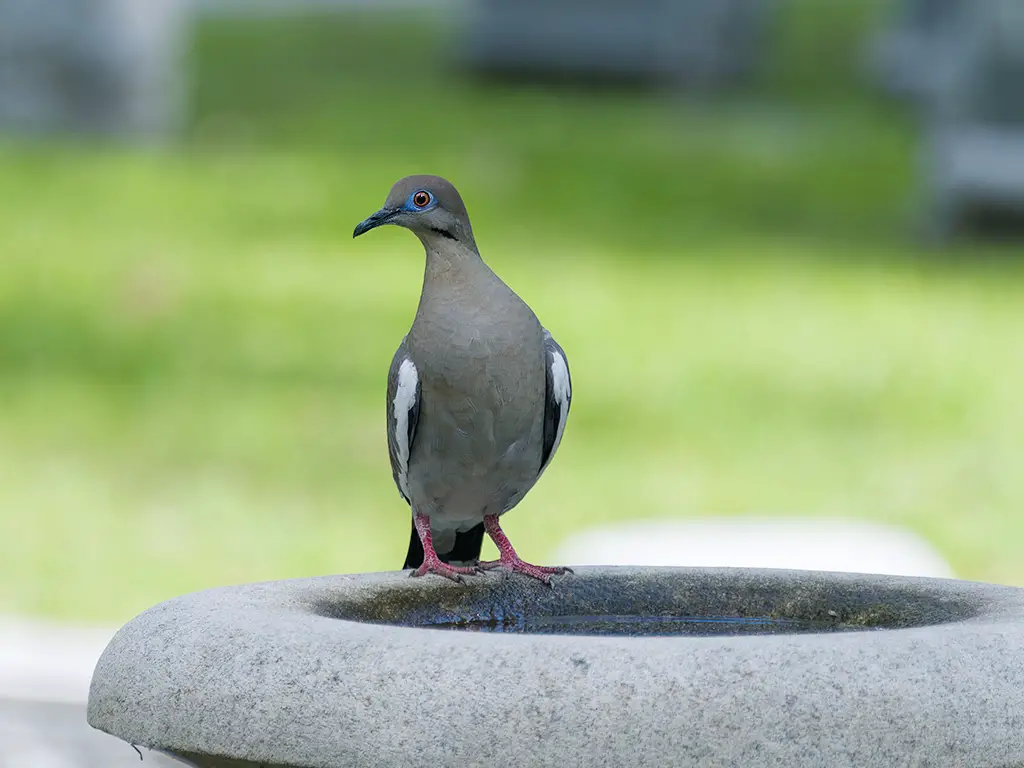
The White-winged Dove is an impressive bird with a large body and wingspan. Its distinctive feature is the white edge on its wings, which makes it easily recognizable when in flight.
It has blue eyerings, red eyes, and gray plumage, while juveniles are duller in coloration than adults.
This dove species inhabits areas from the Southwestern United States through Mexico to Central America as well as Caribbean islands.
They usually live close to human settlements or cities but can also be found in agricultural fields feeding on grains like corn or wheat seeds left by farmers after harvest season ends.
In their natural habitat, they feed primarily on insects, fruits, and small plants such as certain cacti species.
Scientific classification:
| Kingdom | Animalia |
| Phylum | Chordata |
| Class | Aves |
| Order | Columbiformes |
| Family | Columbidae |
| Genus | Zenaida |
| Species | Z. asiatica |
14. Ruby-Crowned Kinglet
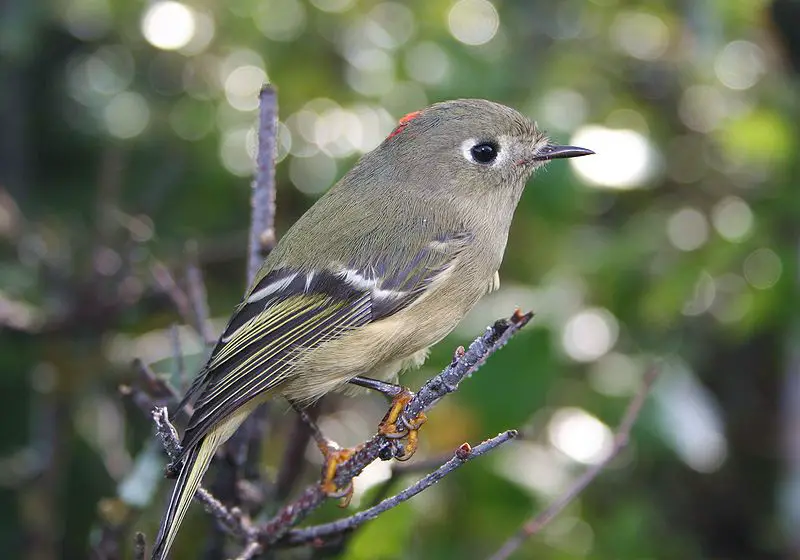
The Ruby-crowned Kinglet is a small passerine bird native to North America. It has olive-green plumage, white wing bars, and an eye-ring as well as a distinctive red crown patch on the males.
Juveniles look similar to adults with no distinguishing features other than size.
They are usually found in coniferous forests or woodlands where they spend much of their time searching for insects among foliage and branches while constantly flitting from place to place.
These birds have incredible energy levels that allow them to travel long distances during migration season without getting exhausted too quickly, making them one of nature’s most resilient species.
Scientific classification:
| Kingdom | Animalia |
| Phylum | Chordata |
| Class | Aves |
| Order | Passeriformes |
| Family | Regulidae |
| Genus | Corthylio Cabanis, 1853 |
| Species | C. calendula |
15. White-Crowned Sparrow
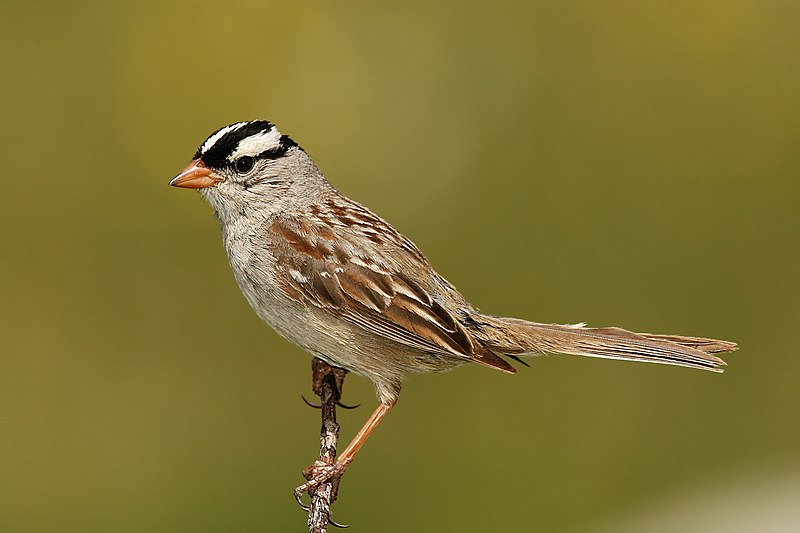
The White-crowned Sparrow is a species of passerine bird native to North America. It has a grey face and black and white streaking on its upper head, making it easy to identify.
This sparrow usually breeds in brushy areas located in the taiga, tundra, Rocky Mountains, or Pacific coast regions of North America.
During winter months these birds migrate southward as far as Mexico and California where they can be found living amongst chaparral shrubbery or low bushes near open fields with plenty of seeds nearby.
The diet of this bird consists mainly of insects during summer while they switch over to eating grains like wheat & oats during colder months when bugs are scarce.
They are known for their characteristic chirp which sounds like “Oh sweet Canada Canada” drawing admirers from around the world.
Scientific classification:
| Kingdom | Animalia |
| Phylum | Chordata |
| Class | Aves |
| Order | Passeriformes |
| Family | Passerellidae |
| Genus | Zonotrichia |
| Species | Z. leucophrys |
16. Gambel’s Quail

Gambel’s quail is a small bird belonging to the New World Quail family, found in desert regions of Arizona, California, and other states. These birds inhabit dry areas with sparse vegetation such as cacti and shrubs.
They are named after William Gambel who explored much of the Southwestern United States during his lifetime.
This species has gray plumage on its body with a white underside and an eye-catching black plume that lies flat against its head when not displaying or calling out for mates during breeding season.
During these times they will also form large coveys (groups) which can range from 10 – 40 individuals.
When alarmed this group usually hides under nearby brush until danger passes – making them difficult to spot even in open terrain due to their camouflage coloration.
Scientific classification:
| Kingdom | Animalia |
| Phylum | Chordata |
| Class | Aves |
| Order | Galliformes |
| Family | Odontophoridae |
| Genus | Callipepla |
| Species | C. gambelii |
Also Featured In: Common Birds That Live in Las Vegas, Birds that Live in Arizona Desert
17. American Robin

The American robin is a migratory bird, belonging to the true thrush genus and Turdidae family.
It was named after its European counterpart due to the similar reddish-orange breast they both possess; however, they are not related closely.
This species can be seen through most of North America during winter months, as well as in parts of Mexico and Central America where it also breeds.
They have plump bodies with gray upperparts and white underparts that vary from yellow on their throats down to orange toward their bellies.
Robins feed on fruits such as berries or insects like worms which makes them an important part of ecosystems by helping disperse seeds naturally throughout these areas.
Scientific classification:
| Kingdom | Animalia |
| Phylum | Chordata |
| Class | Aves |
| Order | Passeriformes |
| Family | Turdidae |
| Genus | Turdus |
| Species | T. migratorius |
18. Yellow-Rumped Warbler
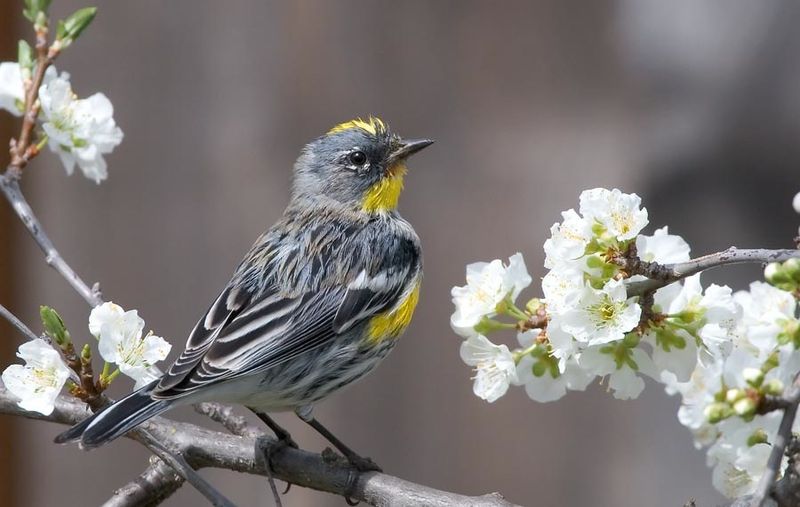
The Yellow-rumped Warbler (Setophaga coronata) is a migratory bird species that can be found throughout North America.
It has an extensive range, from the Pacific and Atlantic coasts of the US to Canada and Central America, with a concentration in northern areas during the breeding season.
These birds migrate southwards for wintering grounds where they find plentiful food sources such as insects and berries.
They are easily identified by their yellow patches on either side of their tails, along with white underparts, gray back feathers, and two distinct crown stripes.
One black or greyish-brown above the eyes extends towards its neck banded in yellow or light brown coloration.
Furthermore, these warblers have strong legs which allow them to cling onto branches while hunting for prey making them adept at maneuvering through tree cover quickly.
Altogether this makes the Yellow-rumped Warbler an attractive backyard visitor year round.
Scientific classification:
| Kingdom | Animalia |
| Phylum | Chordata |
| Class | Aves |
| Order | Passeriformes |
| Family | Parulidae |
| Genus | Setophaga |
| Species | S. coronata |
19. Black Phoebe
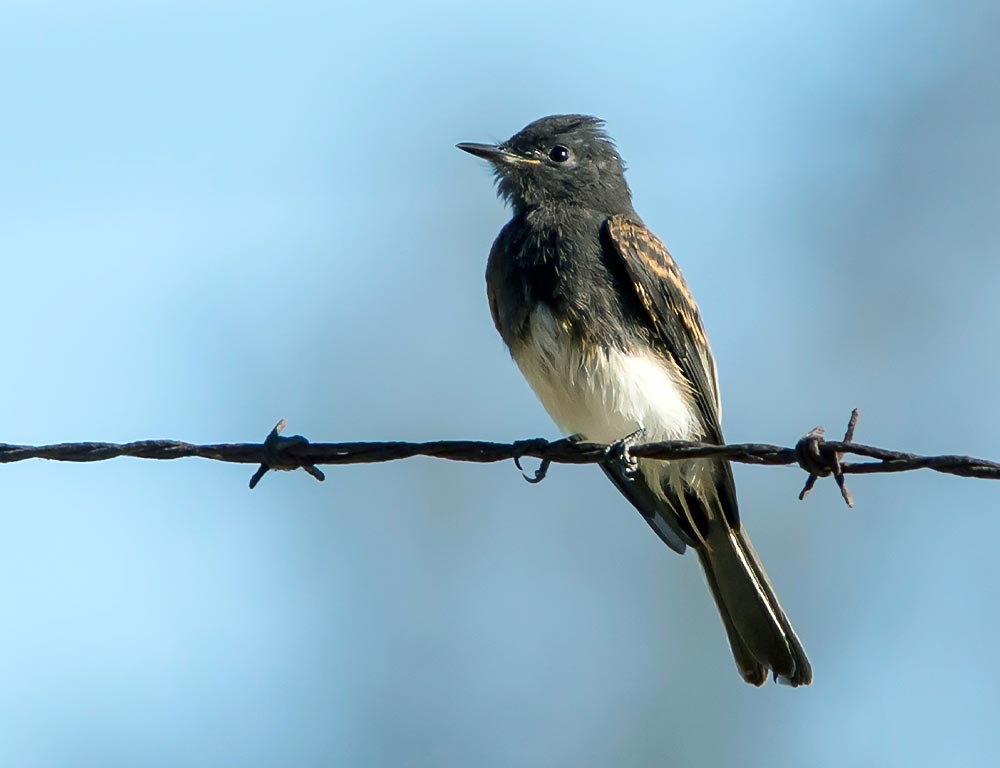
The black phoebe is a beautiful passerine bird belonging to the tyrant flycatcher family. It breeds from southwest Oregon and California south through Central and South America, where it can be found year-round.
However, its northern populations tend to migrate seasonally in some areas. Six subspecies of this species have been identified so far: two are occasional visitors while the others are more common residents in their range.
The adult has mainly dark grey upperparts with a white belly; juveniles may show brownish tones instead of grey ones on their back.
Its main diet consists of insects which it catches by hovering over water or flying out after them from perches near rivers or streams – hence why they’re often seen around these places.
Scientific classification:
| Kingdom | Animalia |
| Phylum | Chordata |
| Class | Aves |
| Order | Passeriformes |
| Family | Tyrannidae |
| Genus | Sayornis |
| Species | S. nigricans |
20. American Goldfinch
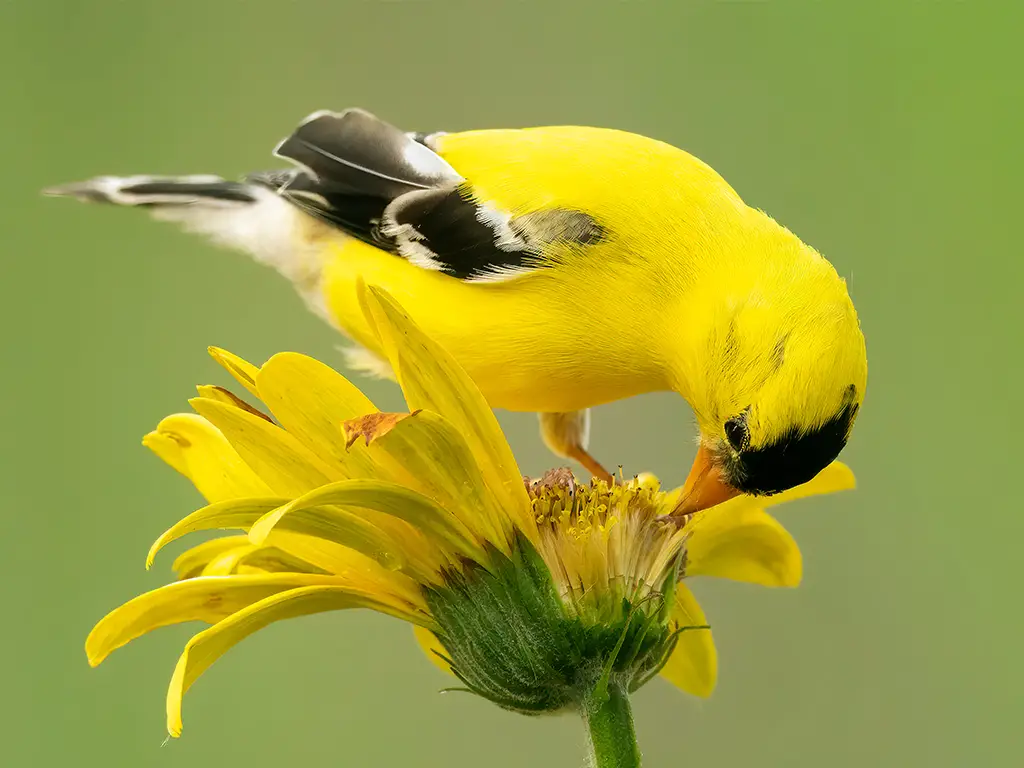
The American goldfinch is a small North American bird in the finch family. Males are vibrant yellow with black wings and tails, while females are duller in coloration.
It migrates from mid-Alberta to North Carolina during the breeding season, south of Canada–United States border to Mexico for its wintering grounds.
The only finch that undergoes complete molt every year, it displays sexual dichromatism where males have brighter colors than their female counterparts.
They feed mainly on seeds but also eat insects such as aphids and caterpillars when raising young; they often occur near thistles or other plants that produce viable seed heads.
Their call consists of an array of chirps and trills making them quite conspicuous.
Scientific classification:
| Kingdom | Animalia |
| Phylum | Chordata |
| Class | Aves |
| Order | Passeriformes |
| Family | Fringillidae |
| Subfamily | Carduelinae |
| Genus | Spinus |
| Species | S. tristis |
21. Great-Tailed Grackle
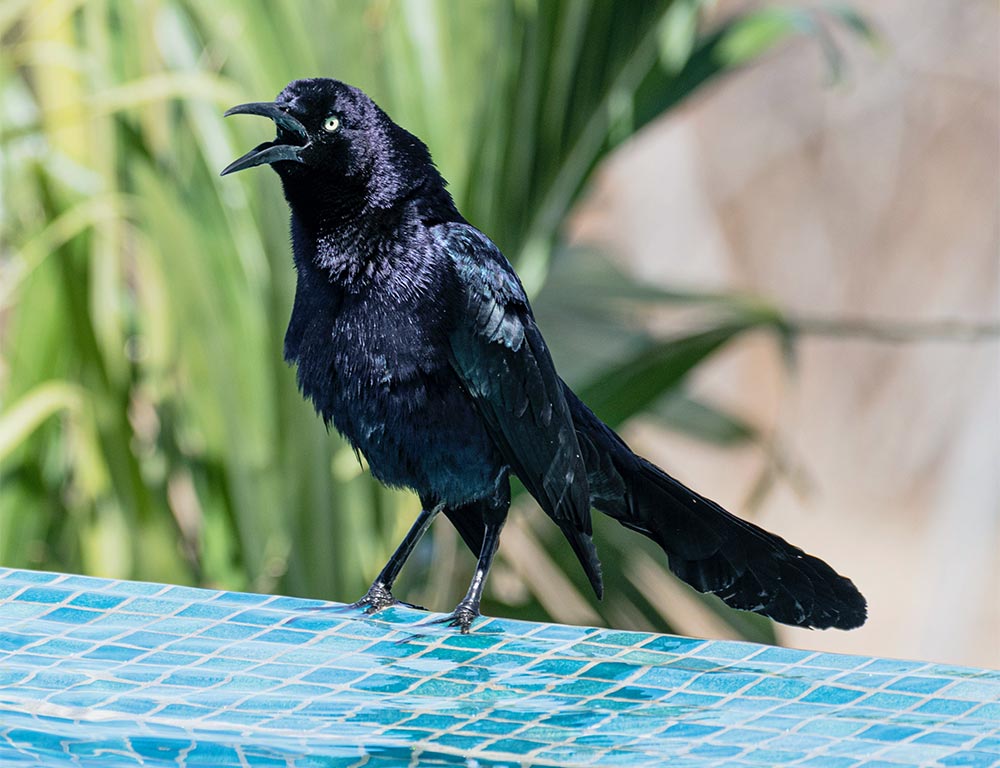
The Great-tailed Grackle is a medium-sized bird native to North and South America. It belongs to the family Icteridae, making it closely related to two other species of grackles – the Boat-tailed and Slender-billed.
They are highly social birds which often appear in large flocks or colonies.
Their plumage ranges from glossy black with blue or purple iridescence, through brownish-grey shades depending on location.
In some areas, they have been known as “blackbirds” due to their predominately dark coloring.
This adaptable species is also renowned for its distinctive long tail feathers – hence its name.
Scientific classification:
| Kingdom | Animalia |
| Phylum | Chordata |
| Class | Aves |
| Order | Passeriformes |
| Family | Icteridae |
| Genus | Quiscalus |
| Species | Q. mexicanus |
22. White-Breasted Nuthatch
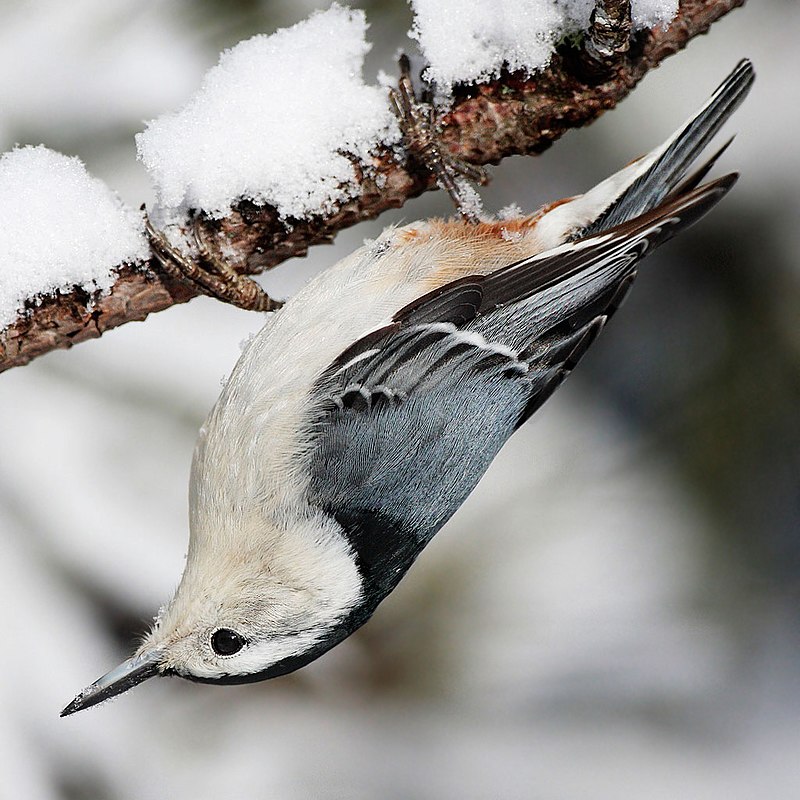
The White-breasted Nuthatch is a medium-sized bird belonging to the nuthatch family Sittidae. It measures around 15.5 cm in length and its color varies throughout its range.
Males have a light blue-grey upperpart, with a black crown and nape whereas females have a dark grey crown instead of a black one.
The underparts are whitish, with reddish tinge on the sides and flanks while the bill is short and stout with a pale base near the eyes which can be yellow or white depending upon geographic location..
This species feeds mainly on insects but will also eat seeds, nuts, and berries when available.
They prefer open woodlands where they often climb trees searching for food along trunks as well as branches underneath bark crevices creating their nest there too.
Scientific classification:
| Kingdom | Animalia |
| Phylum | Chordata |
| Class | Aves |
| Order | Passeriformes |
| Family | Sittidae |
| Genus | Sitta |
| Species | S. carolinensis |
23. Ladder-Backed Woodpecker
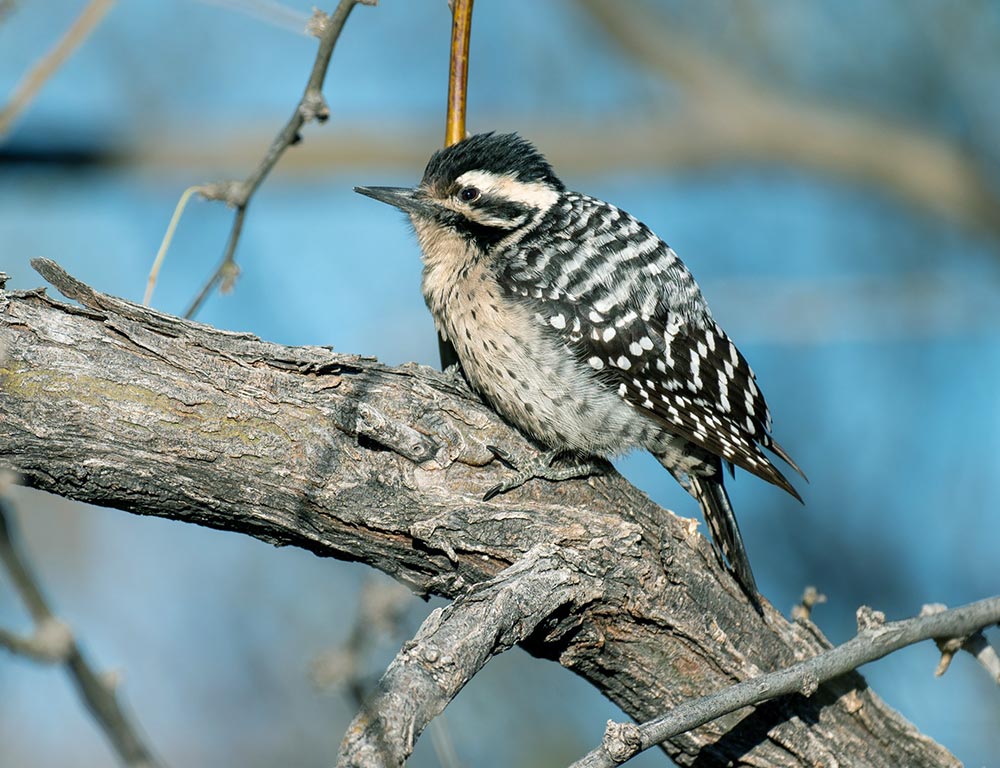
The Ladder-backed Woodpecker is a small black and white bird native to North America.
At about 16.5-19 cm in length, it has a characteristic barred pattern on its back resembling the rungs of a ladder, as well as speckled black rump and cream-colored underparts on its breast and flanks.
These birds can be found inhabiting woodlands across their range, where they feed mostly on insects that they find by drilling into trees or hunting from exposed branches.
Their call consists of short chirps repeated every few seconds with an occasional longer trill thrown in for good measure.
They are also known to use twigs or other objects to probe crevices while searching for food – making them quite resourceful hunters indeed.
Scientific classification:
| Kingdom | Animalia |
| Phylum | Chordata |
| Class | Aves |
| Order | Piciformes |
| Family | Picidae |
| Genus | Dryobates |
| Species | D. scalaris |
24. Red-Winged Blackbird

The red-winged blackbird is a beautiful bird found in most of North America and Central America.
Its distinct features include a glossy black body, with white shoulder patches and bright red wing coverts year round.
It prefers wetland habitats such as marshes, ponds, lakeshores, and agricultural fields. During breeding season they inhabit grassy areas near water then move south for the winter months.
For food they mainly eat insects but also consume wild fruit or grains.
They are very social birds often seen in large flocks during migration times when their unmistakable “conk-la-ree” call can be heard echoing across the sky.
Scientific classification:
| Kingdom | Animalia |
| Phylum | Chordata |
| Class | Aves |
| Order | Passeriformes |
| Family | Icteridae |
| Genus | Agelaius |
| Species | A. phoeniceus |
25. Say’s Phoebe
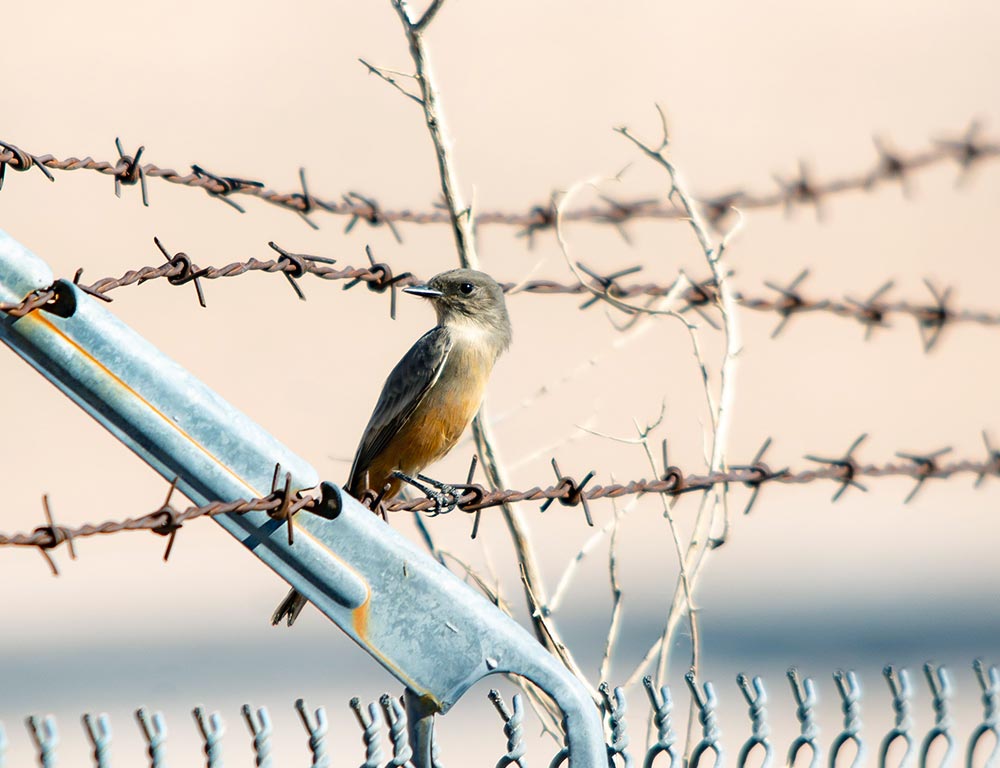
Say’s phoebe is a bird from the tyrant flycatcher family native to western North America. It was named for American naturalist Thomas Say, who first described it in 1825.
This species prefers dry and desolate areas as its habitat. Its brown plumage with whitish underside makes it quite easy to spot among other birds of similar size.
They are also known for their distinctive call; “phoe-bee” which they repeat often throughout the day while perched on fence posts or tree branches scanning their surroundings looking out for food sources such as flying insects, small frogs, and lizards, etc.
Their nests are made up of plant materials like grasses lined with hair or feathers placed inside cavities either under overhangs or in abandoned structures like barns and sheds providing ample protection against predators such as hawks and foxes.
Scientific classification:
| Kingdom | Animalia |
| Phylum | Chordata |
| Class | Aves |
| Order | Passeriformes |
| Family | Tyrannidae |
| Genus | Sayornis |
| Species | S. saya |
26. Elegant Trogon
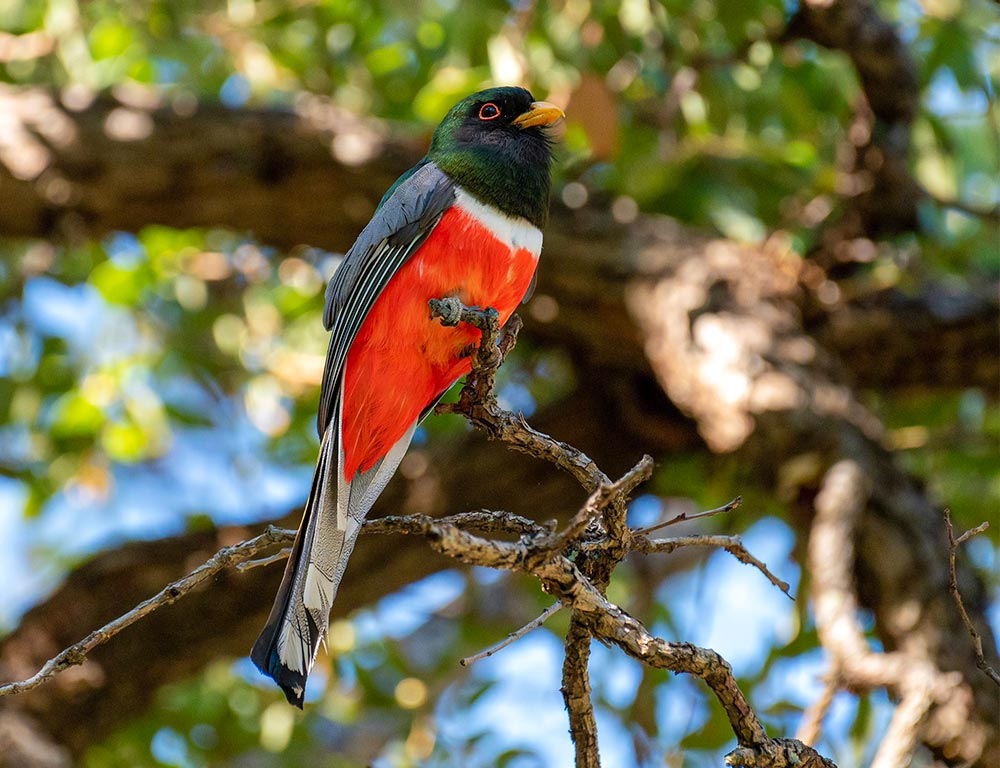
The Elegant trogon is a majestic bird of the Trogon family. It has an impressive coppery-tailed plumage, which gives it its name.
This eye-catching species can be found in Central America and parts of South America and Mexico.
Its five recognized subspecies inhabit different geographical areas with slightly varying physical features and colors on their feathers.
The most distinct among these is Trogon ambiguus, which some classify as a separate species due to its unique characteristics such as more prominent stripes on its head and back, along with duller shades of red compared to other subspecies within the same genus.
Overall this stunningly beautiful omnivore fascinates admirers all over the world for being one of nature’s best works.
Scientific classification:
| Kingdom | Animalia |
| Phylum | Chordata |
| Class | Aves |
| Order | Trogoniformes |
| Family | Trogonidae |
| Genus | Trogon |
| Species | T. elegans |
Also Featured In: Red birds You’ll See in Arizona, Most Common Birds of Nuevo Leon
27. Black-Chinned Hummingbird
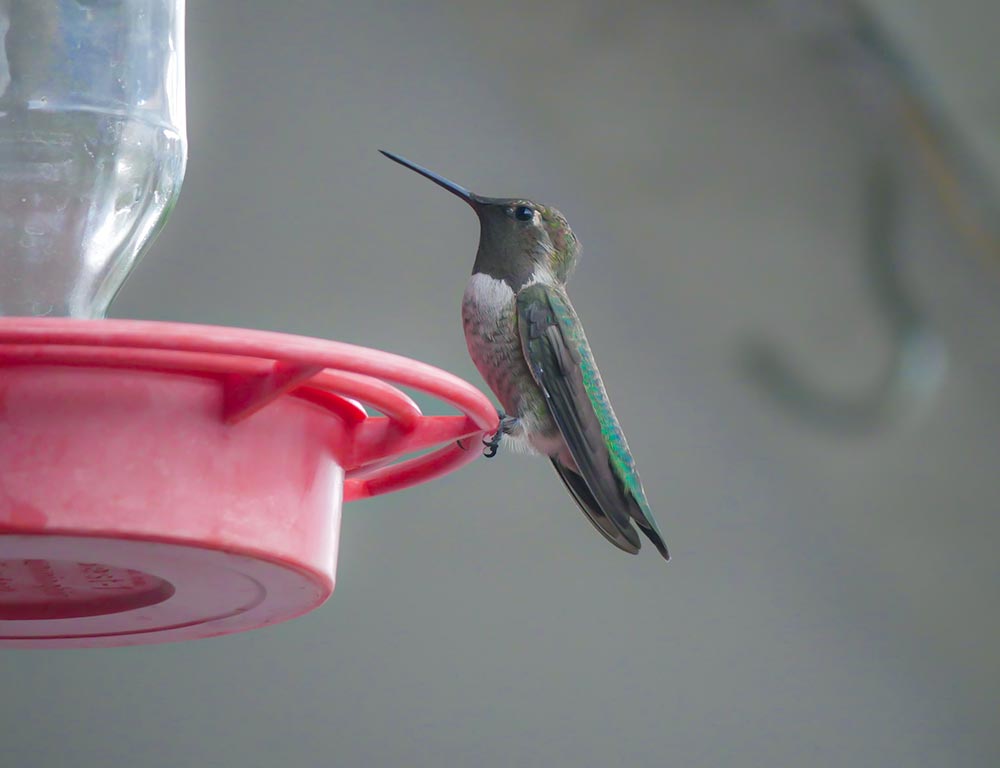
The Black-chinned Hummingbird (Archilochus alexandri) is a small but widely distributed bird. It migrates to Mexico for the winter months, and in summer can be found across much of North America.
The Black-chinned Hummingbird has been known to hybridize with several other species such as Anna’s, Lucifer, Broad-tailed, and Costa’s hummingbirds.
It prefers open habitats like desert scrub or grasslands that provide plenty of nectar from flowers.
These birds are also capable flyers, able to reach speeds of up to 34 miles per hour. With its dazzling plumage and impressive flying skills the Black-chinned Hummingbird makes an intriguing sight for any nature enthusiast lucky enough to spot one in the wild.
Scientific classification:
| Kingdom | Animalia |
| Phylum | Chordata |
| Class | Aves |
| Order | Apodiformes |
| Family | Trochilidae |
| Genus | Archilochus |
| Species | A. alexandri |
28. Pyrrhuloxia
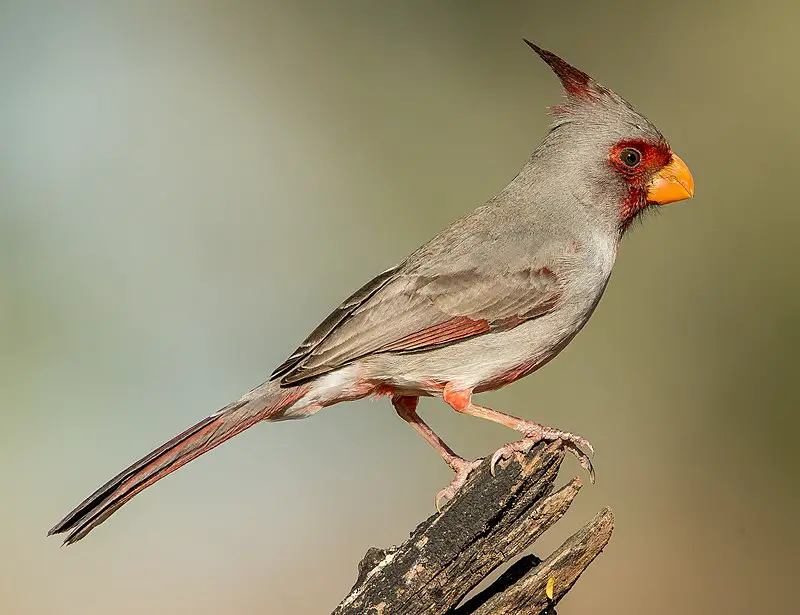
The Pyrrhuloxia, also known as the desert cardinal, is a stunningly beautiful bird native to the American Southwest and northern Mexico.
With its red crest and wings, and short stout bill, it closely resembles the Northern Cardinal and Vermilion Cardinal of its same genus.
It has an average size compared to other songbirds in this area at around 18cm long with a wingspan of up to 28 cm wide.
Its diet mainly consists of small insects such as grasshoppers but they will occasionally eat some fruit or seeds too.
The Pyrrhuloxia’s singing ability rivals many birds in that region due to their clear whistles which can be heard from afar on quiet mornings.
The beauty of these birds makes them very popular among birdwatchers who come from all over just for a chance glimpse of one.
Scientific classification:
| Kingdom | Animalia |
| Phylum | Chordata |
| Class | Aves |
| Order | Passeriformes |
| Family | Cardinalidae |
| Genus | Cardinalis |
| Species | C. sinuatus |
Also Featured In: Red Birds You’ll See in Oklahoma, Red Birds You’ll Commonly Found in Texas
29. Broad-Billed Hummingbird
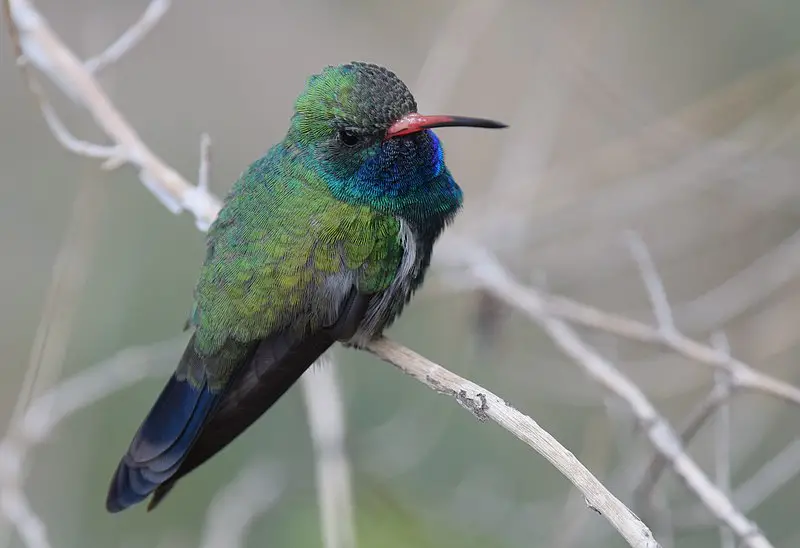
The Broad-billed Hummingbird is a small species of hummingbird that can be found in Mexico and the southwestern United States.
It has distinctive sexual dimorphism, with females resembling their juvenile counterparts more than males do.
This bird stands out thanks to its bright colors and broad, red bill. Other common names for this species include Colibri Mexicano (Spanish) or Mexican Hummingbird.
The Broad-billed usually nests on trees or shrubs near streams but may also occupy wooded areas or gardens close by human settlements during wintertime.
They feed mainly on nectar from flowers while supplementing their diet with insects depending on availability of prey items as well as seasonality changes throughout their range area.Scientific classification:
| Kingdom | Animalia |
| Phylum | Chordata |
| Class | Aves |
| Order | Apodiformes |
| Family | Trochilidae |
| Genus | Cynanthus |
| Species | C. latirostris |
30. Brown-Headed Cowbird
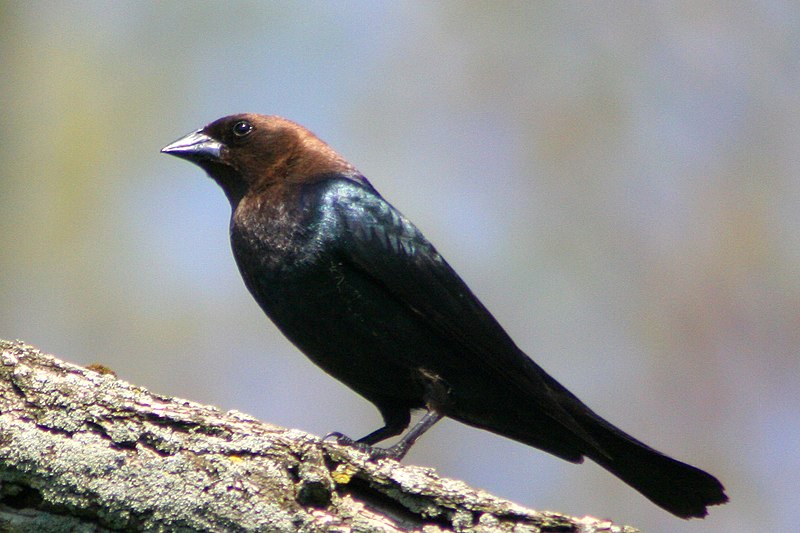
The Brown-headed Cowbird is a small, obligate brood parasitic icterid native to temperate and subtropical North America. It has a brown head with glossy black plumage on the body, wings, and tail feathers.
During summer months it can be found in prairies, grasslands as well as open wooded areas but during winter they migrate southwards towards the United States of Mexico for warmer climates.
They are mainly insectivorous birds that feed on insects like caterpillars or beetles but also consume some grains.
The female bird lays its eggs in nests of other species and then incubates them until hatching time thus leaving their chicks uncared for by themselves.
Scientific classification:
| Kingdom | Animalia |
| Phylum | Chordata |
| Class | Aves |
| Order | Passeriformes |
| Family | Icteridae |
| Genus | Molothrus |
| Species | M. ater |
31. Yellow-Headed Blackbird
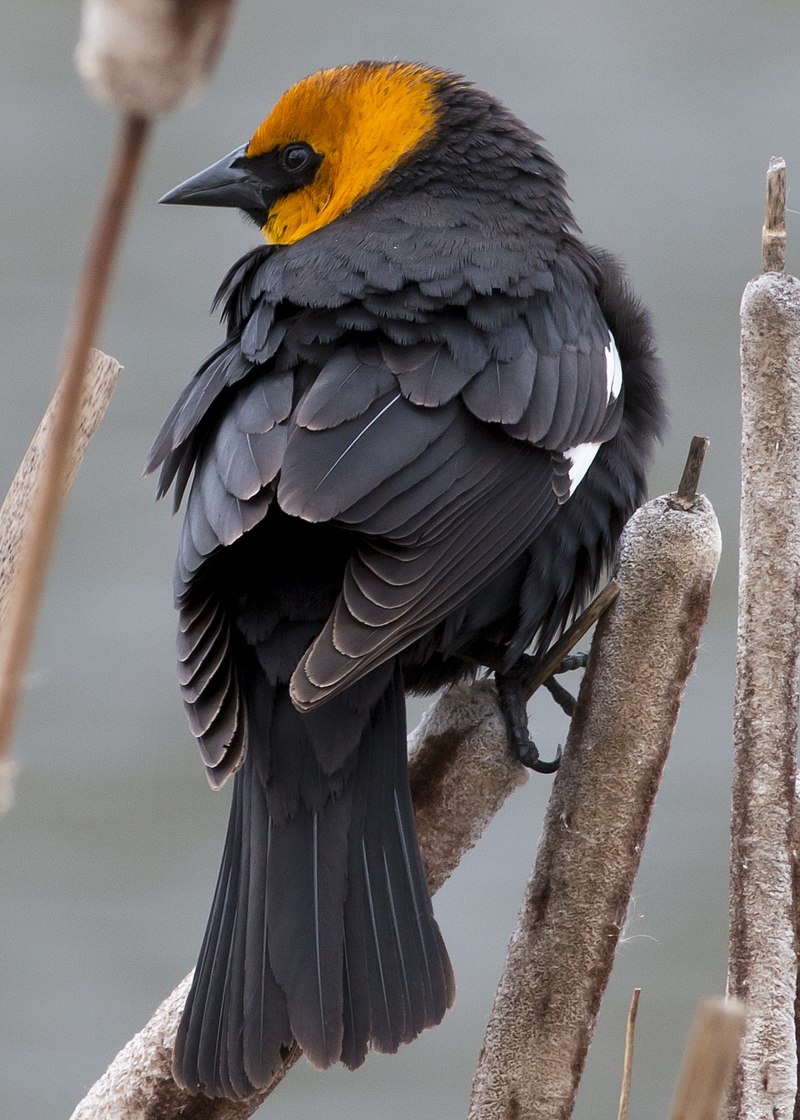
The yellow-headed blackbird is a medium-sized bird with striking features – its head and neck are bright yellow, while the rest of its body is black.
It has large eyes, a pointed bill, and long wings that help it to soar through the air.
The species gets its name from Greek words meaning ‘yellow’ (xanthous) and ‘head’ (cephalus).
This species can be found in wetlands across North America during summer months where they feed on insects and other invertebrates such as snails, earthworms, spiders, and crustaceans.
During winter months they migrate southward for food or when temperatures drop too low for their comfort.
They also form flocks which makes them more visible than solitary birds like hawks or owls. Yellow-headed Blackbirds make beautiful sounds that echo around wetland areas; these melodic calls bring joy to many nature lovers.
Scientific classification:
| Kingdom | Animalia |
| Phylum | Chordata |
| Class | Aves |
| Order | Passeriformes |
| Family | Icteridae |
| Genus | Xanthocephalus Bonaparte, 1850 |
| Species | X. xanthocephalus |
32. New World Warblers
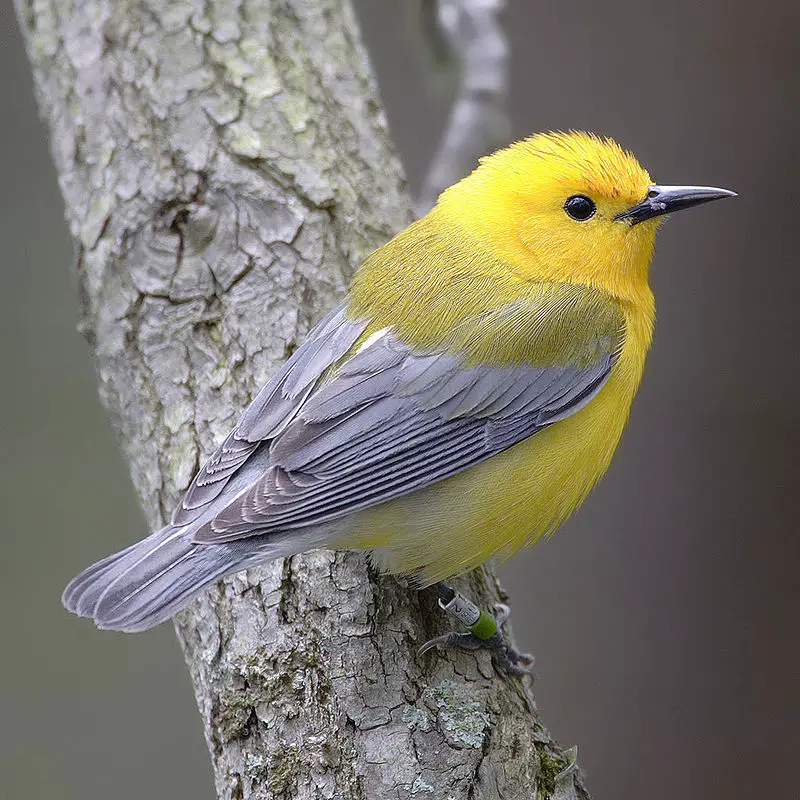
New World warblers are an incredibly diverse family of small birds found only in the Americas. They range in size from tiny hummingbirds to large thrushes and come in a variety of vibrant colors.
All have thin bills made for eating insects which form their main diet. Most species live predominantly arboreal lives, meaning they spend most of their time among trees or bushes searching for food.
However, some members such as ovenbirds and waterthrushes prefer more terrestrial habitats like forest floors where they can scavenge for bugs on the ground instead.
Warblers provide a great source of entertainment with their beautiful songs often filling up woodlands during mornings and evenings throughout springtime.
Scientific classification:
| Kingdom | Animalia |
| Phylum | Chordata |
| Class | Aves |
| Order | Passeriformes |
| Superfamily | Emberizoidea |
| Family | Parulidae Wetmore et al., 1947 |
33. Phainopepla
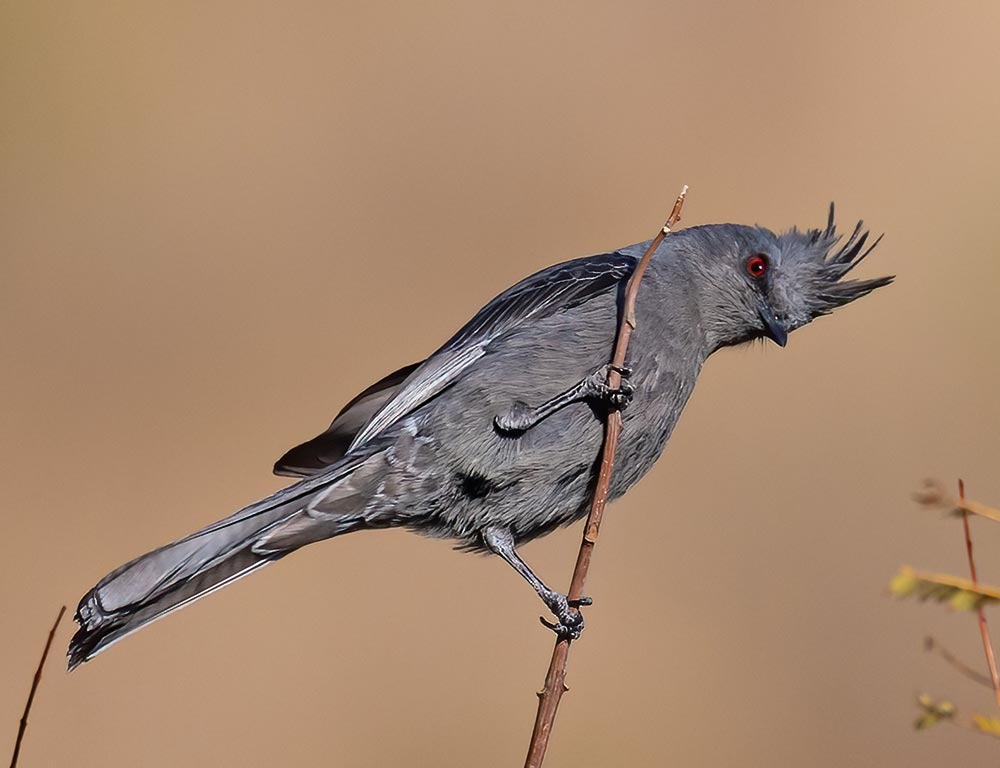
The Phainopepla bird is a stunning species to behold. It has an iridescent black plumage and stands 16-20 cm long with a noticeable crest and long tail, giving it the appearance of wearing a ‘shining robe’.
This species belongs to the mainly tropical Central American family Ptiliogonatidae, which are known as silky flycatchers.
Its name derives from Greek origin meaning ‘shining robe’ because of its distinctive male plumage.
The phainopepla is natively distributed throughout North America, where they inhabit areas such as open woodlands and deserts that provide ample food sources like fruits or insects.
As fascinating birds of prey, they have some interesting habits; for example, they will often use their beaks to pry off bark while searching for tasty morsels beneath.
Scientific classification:
| Kingdom | Animalia |
| Phylum | Chordata |
| Class | Aves |
| Order | Passeriformes |
| Family | Ptiliogonatidae |
| Genus | Phainopepla S.F. Baird, 1858 |
| Species | P. nitens |
Also Featured In: Birds You’ll Find in Sonoran,
34. Hooded Oriole

The Hooded Oriole is a medium-sized New World bird with bright, vibrant colors. The male has an orange-to-yellow body and black back, face, tail, and bib.
Its wings have two white bars that stand out against the dark feathers surrounding it. The female is more of an olive coloration but also shows some yellow accents too.
Both sexes have a curved bill which is completely black in colour as well as white wing bars on its wings for easy identification from other birds in the area.
It typically lives in open woodlands or tropical areas where there are plenty of trees providing food sources such as insects and fruit for them to eat while they perch amongst their branches during nesting season.
Scientific classification:
| Kingdom | Animalia |
| Phylum | Chordata |
| Class | Aves |
| Order | Passeriformes |
| Family | Icteridae |
| Genus | Icterus |
| Species | I. cucullatus |
Also Featured In: Birds Live Near San Diego, Common Yellow Birds of Idaho
35. Montezuma Quail
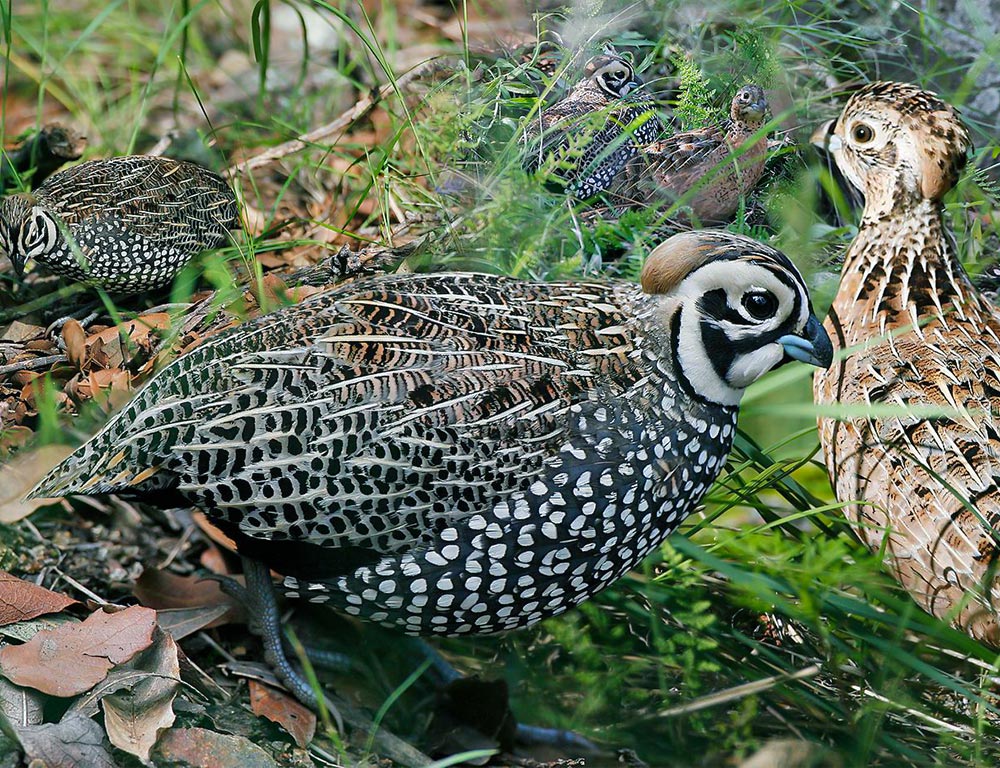
The Montezuma quail, also known as Mearns’s quail, the harlequin quail, and fool quail due to its behavior is a stubby New World bird found in Mexico and some parts of the United States.
It was formally described by Irish zoologist Nicholas Aylward Vigors under the binomial name Ortyx Montezuma in 1830.
This small secretive bird has striking patterning on male birds which gives it another common name – Harlequin Quails.
They inhabit deserts, grasslands, or scrub vegetation for shelter but are shy and difficult to spot even when calling out their distinctive raspy call during mating season.
These birds feed mainly on insects such as beetles, and ants along with seeds and other plant matter making them an important part of maintaining healthy ecosystems where they live.
Scientific classification:
| Kingdom | Animalia |
| Phylum | Chordata |
| Class | Aves |
| Order | Galliformes |
| Family | Odontophoridae |
| Genus | Cyrtonyx |
| Species | C. montezumae |
Also Featured In: Most Common Oaxaca Birds,
36. Lesser Nighthawk
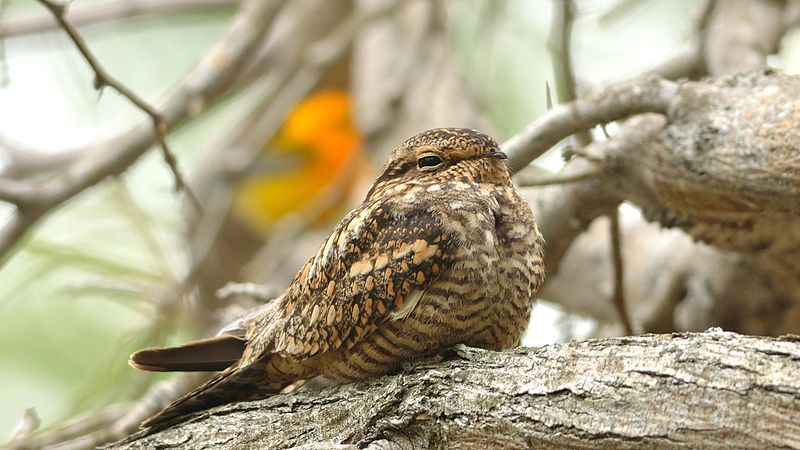
The Lesser Nighthawk is a nocturnal bird found across the Americas. Its dark brown and grey body has white patterning, while its long upper wings are black with a distinctive white bar visible in flight.
The tail is also black with thin white bars, while the underside of its body is buffy-colored and finely streaked with horizontal lines.
Males have a bright white throat while females don’t; they both share an orange eye rim to complete their look.
During mating season males can be seen performing display flights at dusk over open areas like grasslands or riverbanks to impress potential mates.
Scientific classification:
| Kingdom | Animalia |
| Phylum | Chordata |
| Class | Aves |
| Order | Caprimulgiformes |
| Family | Caprimulgidae |
| Genus | Chordeiles |
| Species | C. acutipennis |
Also Featured In: Most Common Birds in Michoacán,
37. Dark-Eyed Junco

The Dark-eyed Junco is a species of small, grayish sparrows that are found across much of temperate North America and in the Arctic during summer.
It was formally described by Carl Linnaeus in 1766, who named it after its distinctive dark eyes.
This bird has a very variable appearance due to the many different subspecies it contains, making its systematics difficult to unravel.
The plumage varies from white or light gray on their underparts with slate grey backs and wings; black heads with white outer tail feathers; brown head stripes; yellow bills; pink legs and feet; as well as various shades between all these colours.
They also have considerable sexual dimorphism where males tend to be more colorful than females but share similar characteristics such as short tails and rounded bodies – both sexes being around 16 cm long when fully grown.
Scientific classification:
| Kingdom | Animalia |
| Phylum | Chordata |
| Class | Aves |
| Order | Passeriformes |
| Family | Passerellidae |
| Genus | Junco |
| Species | J. hyemalis |
38. Pine Siskin
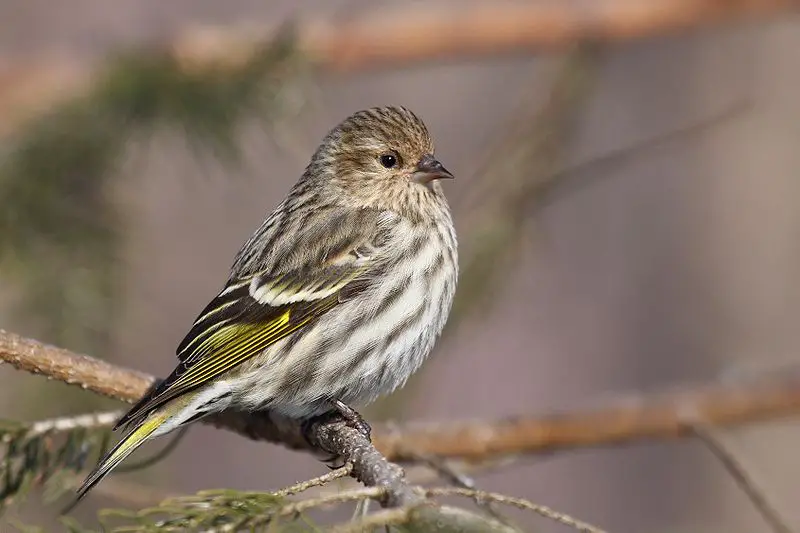
The Pine Siskin is a small bird from the finch family, primarily found in North America. It has an irregular migratory range and was first described by American ornithologist Alexander Wilson in 1810.
The species gets its name pinus, which means “pine tree” in Latin, due to its frequent presence near coniferous trees.
Pine siskins are known for their yellow wing bars and streaked chests as well as their perky mannerisms when perched on branches or flying around looking for food during colder months.
They feed mostly on seeds of weeds, grasses, and other plants but can also be seen consuming insects at times during the summertime nesting season.
Its loud calls often alert nearby birds of potential danger while they nest high up among pine tree limbs where predators cannot reach them easily.
Scientific classification:
| Kingdom | Animalia |
| Phylum | Chordata |
| Class | Aves |
| Order | Passeriformes |
| Family | Fringillidae |
| Subfamily | Carduelinae |
| Genus | Spinus |
| Species | S. pinus |
39. Western Kingbird
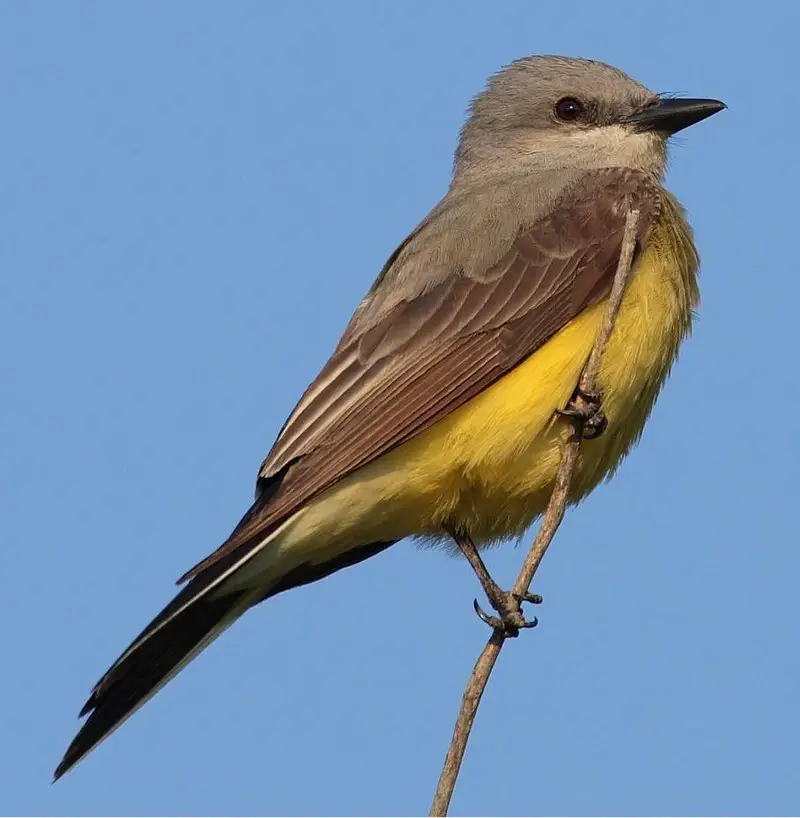
The Western kingbird is a large tyrant flycatcher native to western North America. It has striking plumage, with gray and yellow feathers tinged with crimson during courtship or when defending territory from intruders.
As is characteristic of its kind, the Western Kingbird exhibits highly territorial behavior towards other birds in its area.
They are found as far south as Mexico, inhabiting open habitats near bodies of water such as rivers and lakes.
While their primary diet consists of insects like bees and flies that they catch mid-flight, it also includes fruit for variety during winter months.
The species have recently seen an increase in population due to conservation efforts that aim to protect these beautiful creatures.
Scientific classification:
| Kingdom | Animalia |
| Phylum | Chordata |
| Class | Aves |
| Order | Passeriformes |
| Family | Tyrannidae |
| Genus | Tyrannus |
| Species | T. verticalis |
40. Black-Throated Sparrow
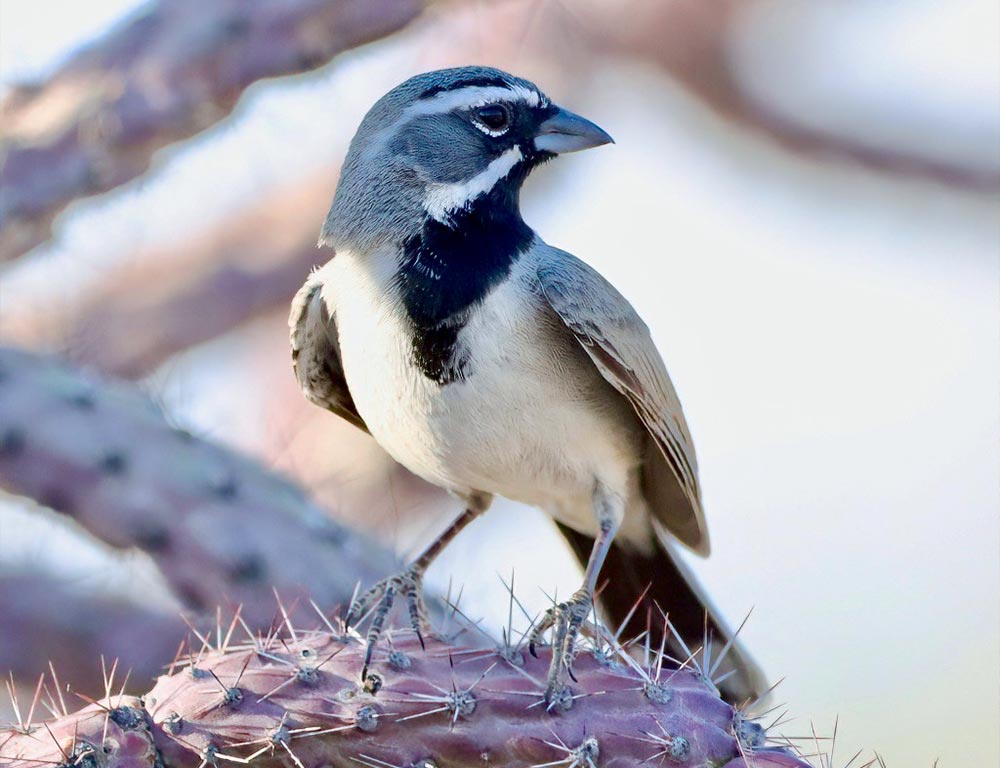
The black-throated sparrow is a small bird native to the southwestern United States and Mexico.
It is known for its striking features, including black throats with white stripes on either side as well as buffy, white underparts.
They are also recognized by their long tails and dark upper parts, which often have yellowish or rusty markings near the wings.
The birds prefer arid habitats such as deserts and scrublands; however, they can be found in other areas too during migration periods.
These adaptable creatures feed on insects, seeds, and grains from plants like grasses or cacti – making them an important species when it comes to sustaining healthy ecosystems.
Scientific classification:
| Kingdom | Animalia |
| Phylum | Chordata |
| Class | Aves |
| Order | Passeriformes |
| Family | Passerellidae |
| Genus | Amphispiza Coues, 1874 |
| Species | A. bilineata |
41. American Yellow Warbler
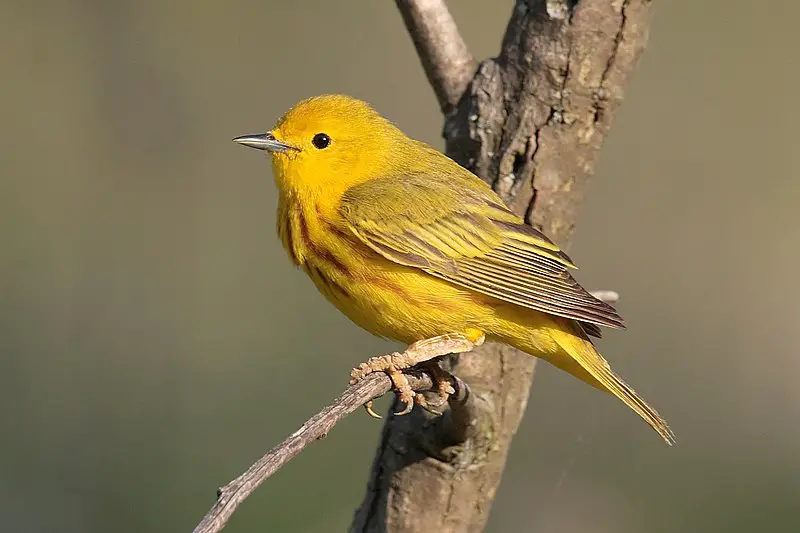
The American Yellow Warbler (Setophaga petechia) is a species of New World warbler found across North America, the Caribbean, and into northern South America.
Its genus name Setophaga comes from Ancient Greek words meaning “moth” and “eating”, while its specific name Petechia originates from Italian for small red spots.
This bird has striking yellow plumage with reddish-brown streaks on their chest that can be seen during mating season when they are most colorful.
They live in open woodlands near wetlands or bodies of water where they can find food such as insects like spiders, beetles, and caterpillars which make up much of their diet.
The male will sing to attract a mate during the breeding season before setting up a home in twig nests built by both sexes together high in trees or shrubs.
Scientific classification:
| Kingdom | Animalia |
| Phylum | Chordata |
| Class | Aves |
| Order | Passeriformes |
| Family | Parulidae |
| Genus | Setophaga |
| Species | S. petechia |
42. Blue-Throated Mountain gem
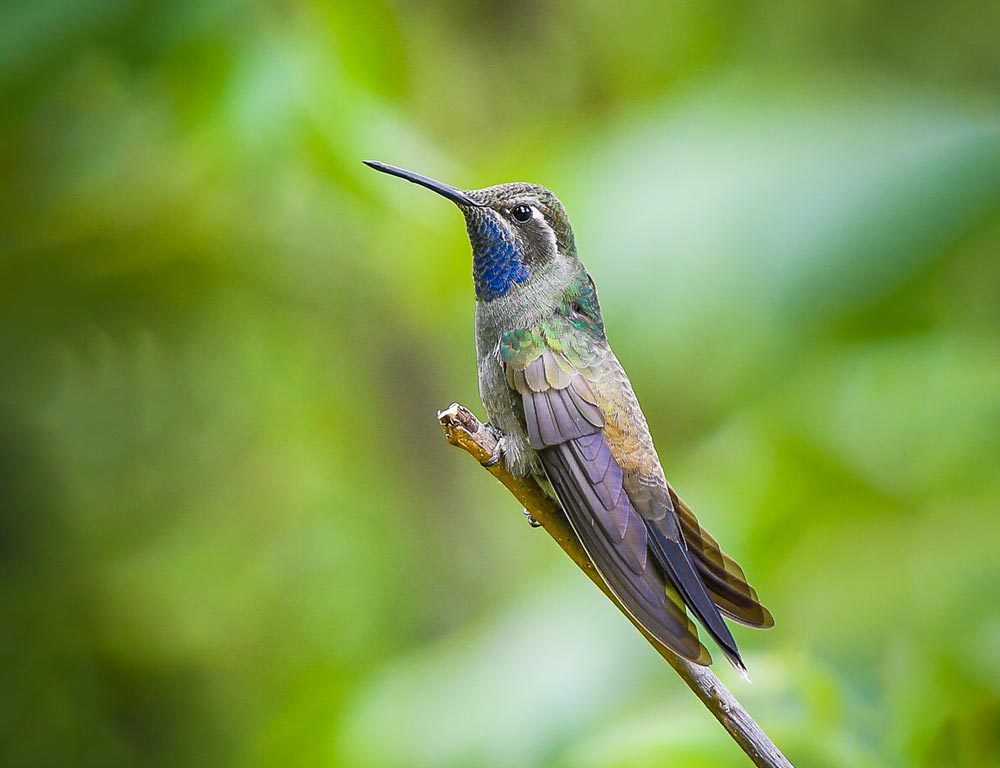
The Blue-throated Mountaingem is a species of hummingbird found in Mexico and the United States. It’s distinctively known for its blue throat, which stands out against its green body feathers.
The bird was once placed into several different genera before being finally settled in the early 20th century with its dedicated genus – Cyanolaem.
This small bird has an impressive wingspan of 6 inches and weighs less than 1 ounce.
Its stunningly colored plumage makes this one of the most beautiful birds to be found across North America, making it popular amongst avid bird watchers who seek out their unique beauty.
Scientific classification:
| Kingdom | Animalia |
| Phylum | Chordata |
| Class | Aves |
| Order | Apodiformes |
| Family | Trochilidae |
| Genus | Lampornis |
| Species | L. clemenciae |
43. Summer Tanager
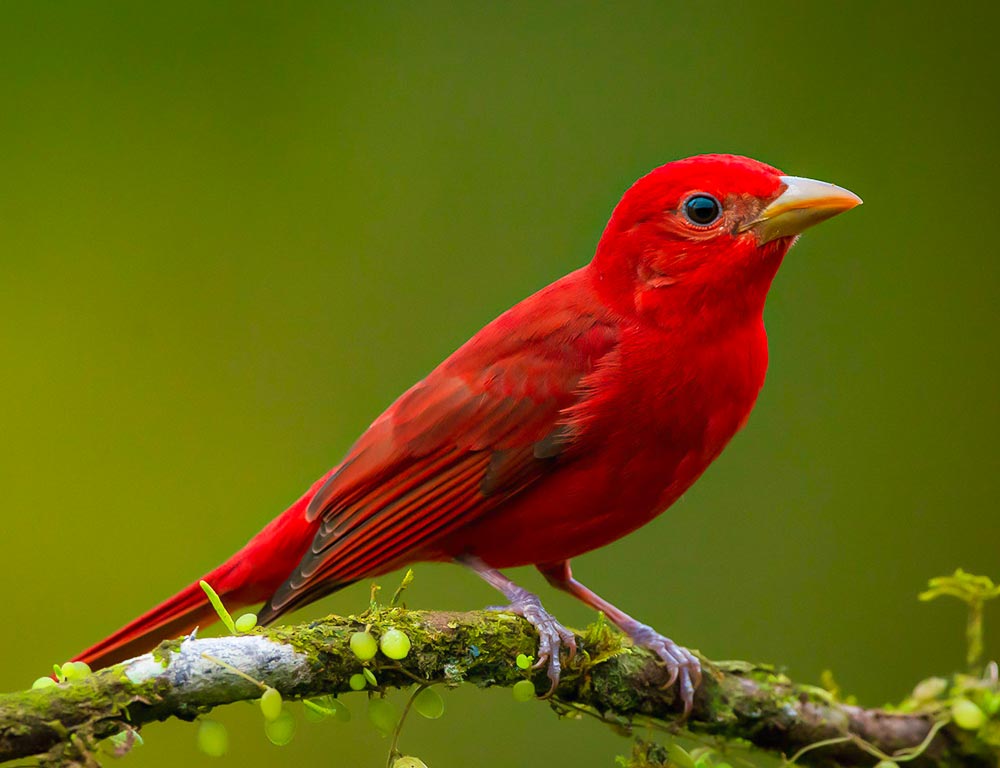
The Summer Tanager is a stunningly beautiful member of the cardinal family. Native to North and South America, this medium-sized songbird features striking red plumage on its back with yellow underparts.
It has a pointed black bill and long tail feathers that can be seen fluttering through the air when it flies.
The species’ vocalizations are quite similar to those of other members of its genus as well, which often include short whistles and chirps in addition to longer songs made up of various phrases or syllables.
With their vibrant colors and melodic voices, these birds make an eye-catching sight any time they appear.
Scientific classification:
| Kingdom | Animalia |
| Phylum | Chordata |
| Class | Aves |
| Order | Passeriformes |
| Family | Cardinalidae |
| Genus | Piranga |
| Species | P. rubra |
44. Steller’s Jay
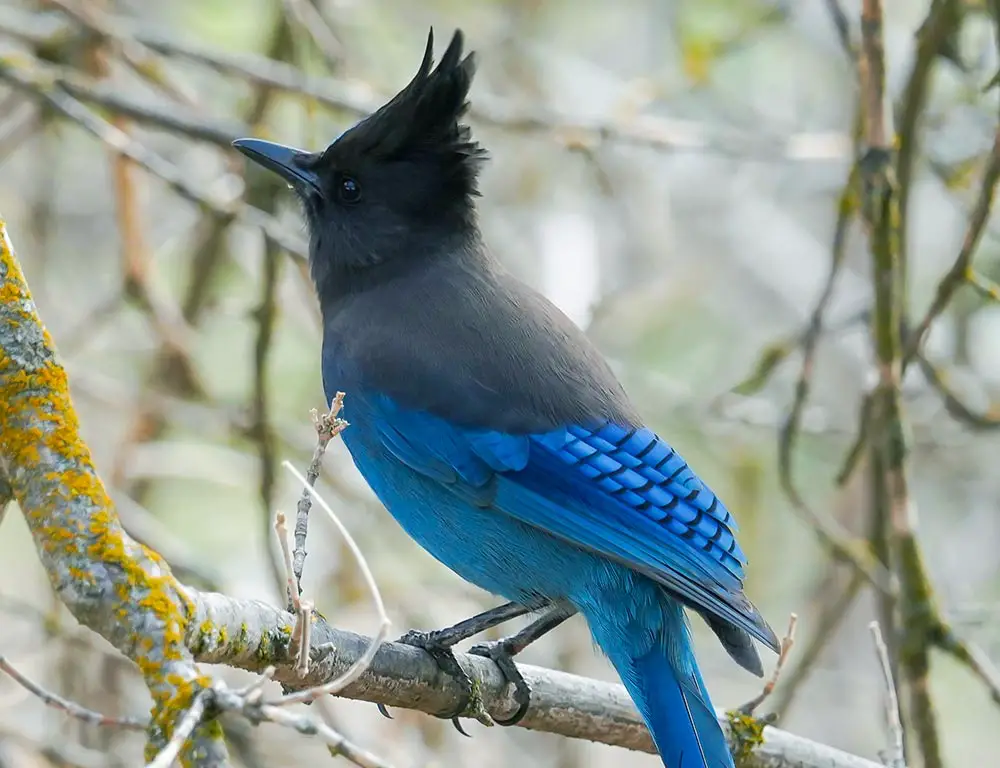
Steller’s jay is a beautiful and colorful bird native to western North America and the mountains of Central America.
It has a distinctive long crest that sets it apart from other birds, with its blue feathers streaked with black, white, gray, and brown markings.
This species is closely related to the blue jays found in eastern North America but can be distinguished by their longer crests.
They are known for being highly vocal birds who like to make loud calls throughout forests they inhabit as well as stealing food from unsuspecting mammals or raiding bird feeders when given the chance.
Steller’s Jays have adapted well to human presence in areas they populate making them great backyard visitors if you’re lucky enough.
Scientific classification:
| Kingdom | Animalia |
| Phylum | Chordata |
| Class | Aves |
| Order | Passeriformes |
| Family | Corvidae |
| Genus | Cyanocitta |
| Species | C. stelleri |
45. Gilded Flicker
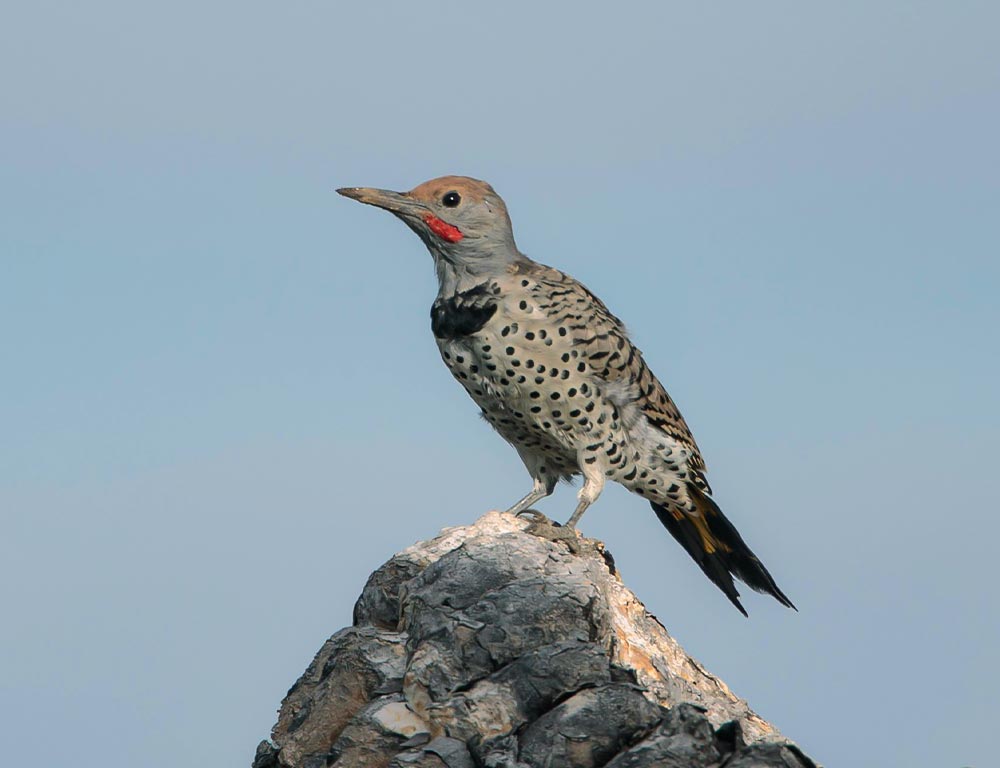
The Gilded Flicker is an impressive and striking bird that can be found in the desert regions of the Southwestern United States and Northwestern Mexico.
It has a mean length of 29 cm (11 inches) which makes it one of the largest woodpeckers.
Its distinguishing feature is its golden-yellow underwings, making it stand out from other species such as the northern flicker in these areas.
This majestic bird mainly consumes insects but may also feed on fruits or berries when available, helping to spread seeds throughout their habitats.
As they are not migratory birds, they remain all year round; hence providing some stability to their local ecosystems.
Scientific classification:
| Kingdom | Animalia |
| Phylum | Chordata |
| Class | Aves |
| Order | Piciformes |
| Family | Picidae |
| Genus | Colaptes |
| Species | C. chrysoides |
46. Purple Martin
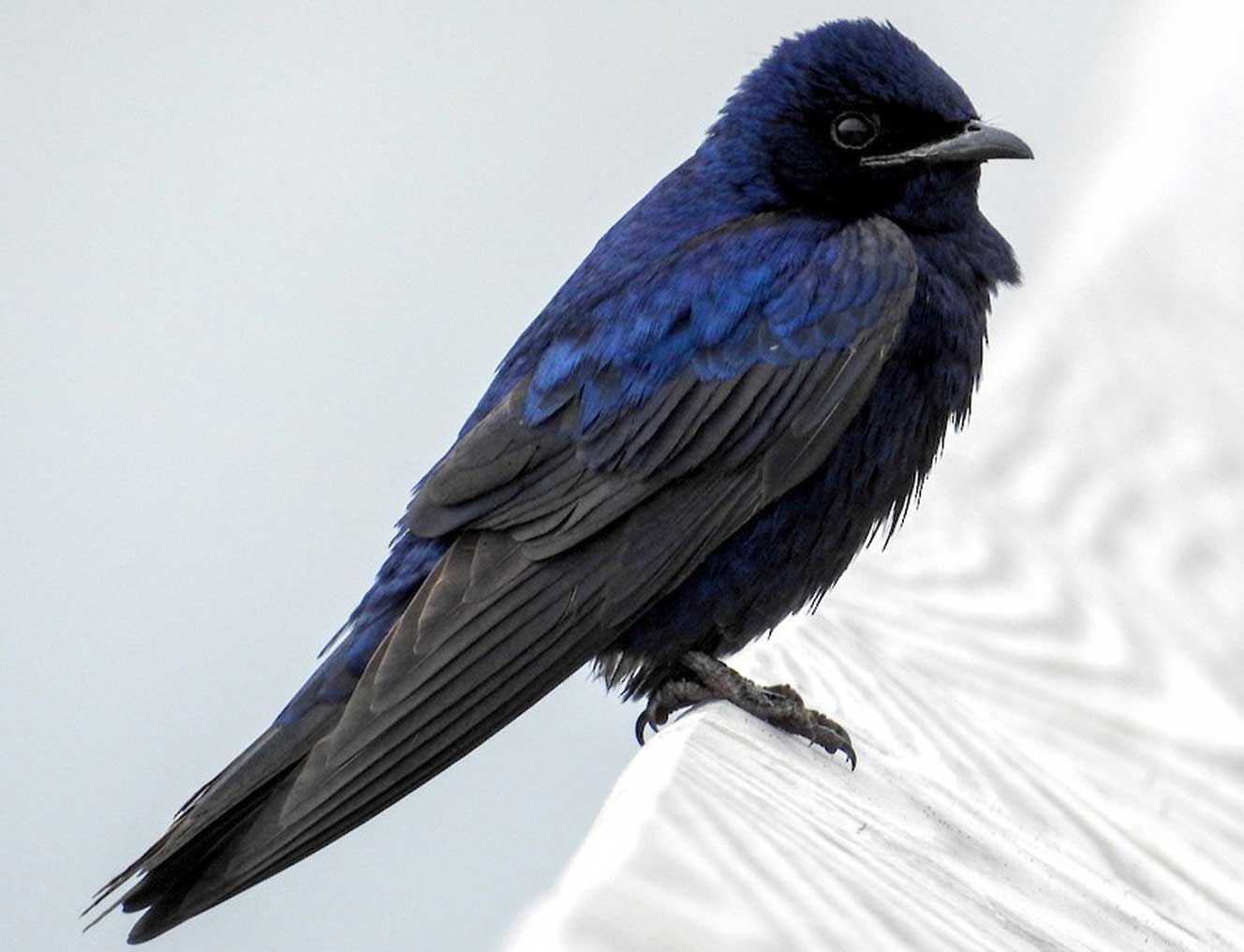
The Purple Martin is a beautiful passerine bird in the swallow family and is the largest of its kind in North America.
It has dark blackish-blue feathers that have an iridescent sheen which can make them appear blue or deep purple depending on the light; they may even look green.
These birds are quite social creatures and often build communal roosts with multiple nests, having as many as hundreds of individuals living together at once.
They feed mainly on flying insects such as flies, moths, wasps, and bees.
Their habitats include areas near bodies of water like lakes or rivers where there’s plenty for these birds to eat all year round.
The Purple Martin is truly an amazing species worth protecting.
Scientific classification:
| Kingdom | Animalia |
| Phylum | Chordata |
| Class | Aves |
| Order | Passeriformes |
| Family | Hirundinidae |
| Genus | Progne |
| Species | P. subis |
47. Costa’s Hummingbird
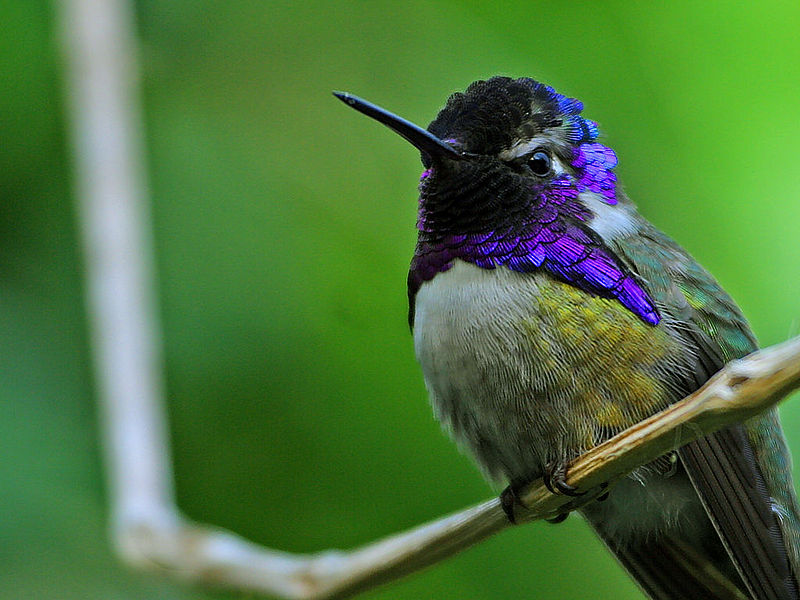
Costa’s hummingbird is a species of the Trochilidae family. It inhabits arid regions in both the southwest United States and northwest Mexico, migrating to western Mexico for wintering purposes.
This bird was named by French ornithologist Jules Bourcier in 1839 after honoring François Coste, who had sent specimens to him from North America.
Costa’s hummingbirds are small birds averaging 3-3.5 inches (7–9cm) long with typically green feathers on their back and tail while underparts are usually greyish or sometimes white with purple highlights around the throat area giving them an iridescent appearance when light hits it the right angle.
Males also have red patches on their forehead which they use as part of courtship display behavior along with singing distinctive “wheep” sounds during mating season.
Scientific classification:
| Kingdom | Animalia |
| Phylum | Chordata |
| Class | Aves |
| Order | Apodiformes |
| Family | Trochilidae |
| Genus | Calypte |
| Species | C. costae |
48. Rivoli’s Hummingbird
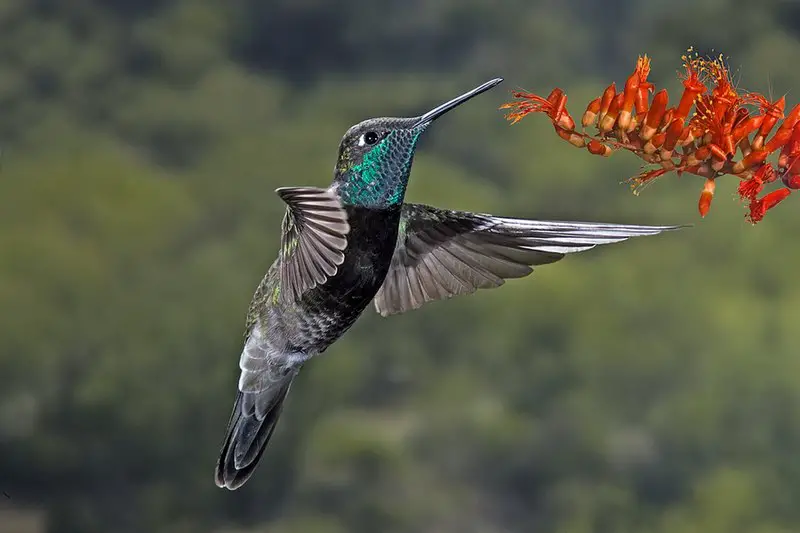
Rivoli’s hummingbird is a beautiful species of bird found in Central and North America. It belongs to the family Trochilinae, also known as “mountain gems”.
The male has an impressive iridescent purple-blue head and throat with a greenish back, while the female has a more subdued coloring.
One unique feature about this species is its long tail feathers which can be up to twice as long as its body length.
This amazing bird feeds on nectar from flowers and insects such as midges, mosquitoes, spiders, and moths; they even feed on sap from trees.
Rivoli’s Hummingbirds are active during the day when their spectacular colors shine brightest making them easy to spot among other birds.
These tiny yet fascinating creatures provide us with endless hours of entertainment – it’s no wonder why they have been so adored over time.
Scientific classification:
| Kingdom | Animalia |
| Phylum | Chordata |
| Class | Aves |
| Order | Apodiformes |
| Family | Trochilidae |
| Genus | Eugenes |
| Species | E. fulgens |
49. California Condor
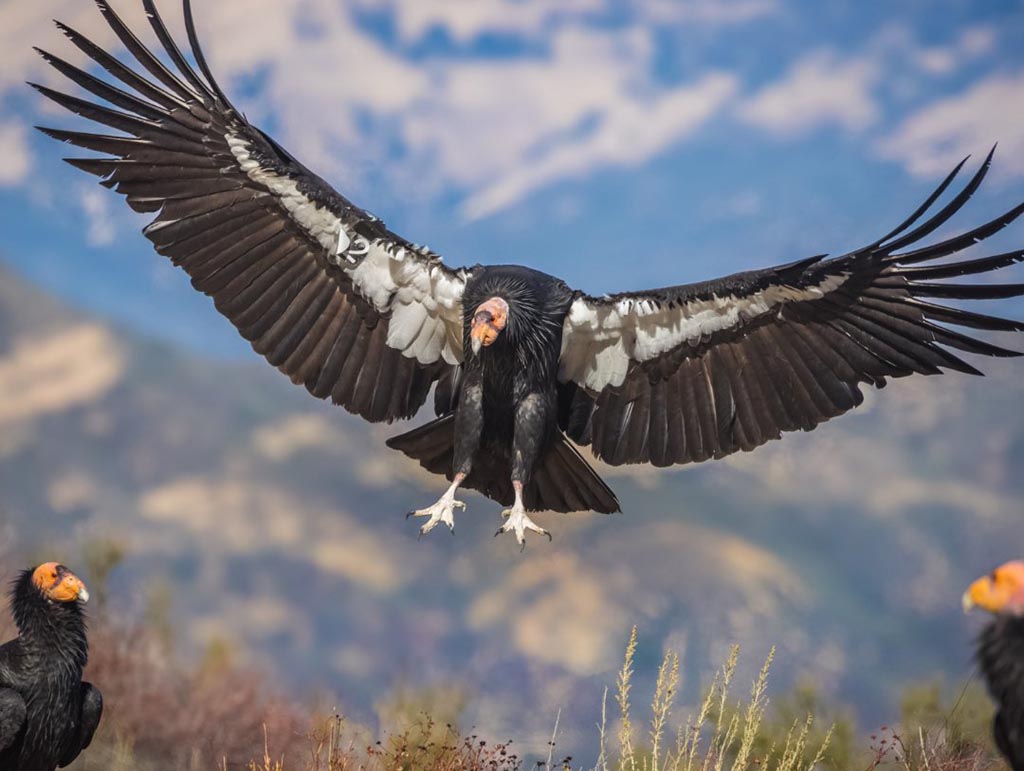
The California condor is a majestic bird, being the largest North American land bird. It was sadly pushed to extinction in the wild back in 1987 when all remaining individuals were captured.
Since then, conservation efforts have allowed for reintroductions of these birds into areas such as northern Arizona and southern Utah, including Zion National Park and Grand Canyon area; coastal mountains of California; and northern Baja California.
The species has been given plenty of protection with numerous laws created to protect it from human interference or disturbance while also helping boost its population size through captive breeding programs.
Thanks to this effort we can now enjoy seeing this incredible species flying across our skies once more.
Scientific classification:
| Kingdom | Animalia |
| Phylum | Chordata |
| Class | Aves |
| Order | Accipitriformes |
| Family | Cathartidae |
| Genus | Gymnogyps |
| Species | G. californianus |
To Recap
Arizona boasts a remarkable diversity of bird species, with a total of 49 distinct avian inhabitants. From the iconic and majestic Bald Eagle to the vibrant and charismatic Vermilion Flycatcher, this southwestern state offers birdwatchers and nature enthusiasts a rich tapestry of avian life to explore.
Whether you’re captivated by the elusive hummingbirds of the Sonoran Desert, the waterfowl gracing its numerous lakes, or the raptors soaring above its rugged landscapes, Arizona’s bird population provides a fascinating window into the state’s unique ecosystems.
The variety of habitats, from deserts to mountains to riparian areas, make Arizona a true haven for bird lovers, with endless opportunities for observation and appreciation.